- Sexual Reproduction in Flowering Plants Important Questions
- Human Reproduction Important Questions
- Reproductive Health Important Questions
- Principles of Inheritance and Variation Important Questions
- Molecular Basis of Inheritance Important Questions
- Evolution Important Questions
- Human Health and Disease Important Questions
- Microbes in Human Welfare Important Questions
- Biotechnology – Principles and Processes Important Questions
- Biotechnology and Its Applications Important Questions
- Organisms and Populations Important Questions
- EcoSystem Important Questions
- Biodiversity and Conservation Important Questions
Class 12 Biology
Important Questions for Class 12 Biology Chapter 2 – Human Reproduction
Important Questions For Class 12 Biology Chapter 2 – Human Reproduction Very Short Question And Answers
Question 1. Breastfeeding the baby acts as a natural contraceptive for the mother because it prevents;
- Ovulation
- Menstruation
- insemination
- Fertilisation
- (2) and (4)
- (1) and (3)
- (1) and (4)
- (1) and (2)
Answer: 2. (1) and (2)
Question 2. The given figure shows the different stages of the human embryo
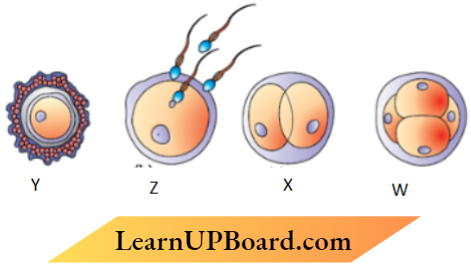
Identify the correct labeling for W, X, and Z, and choose the correct option from the table below.
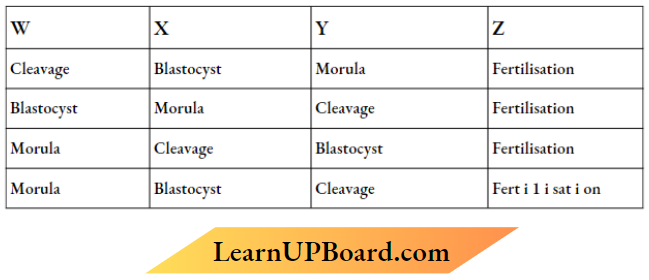
” human reproduction class 12″
Question 3. During human embryonic development, the external genital organs are well-developed in the fetus by the end of
- 6 weeks of pregnancy
- 12 weeks of pregnancy
- 18 weeks of pregnancy
- 24 weeks of pregnancy
Answer: 3. 12 weeks of pregnancy
Read and Learn More Important Questions for Class 12 Biology Chapter Wise
Question 4. The accessory ducts in the human mate reproduct4e system consist of –
- Epididymis, Prostrate. Retetestis
- Rete testis. Vas efferentia. Seminal vesicles
- Vas efferentia. Bulbourethral, epididymis
- Rete testis, epididymis, Vas deferens
Answer: 4. Rete testis, epididymis, Vas deferens
Question 5.Assertion (A): The inner cell mass of the blastocyst gets attached to the endometrium during embryonic development in humans.
Reason (R): The blastomeres in the blastocyst get arranged into trophoblast and inner cell mass.
- Both Assertion (A) and Reason (R) are true and Reason (R) is the correct explanation of Assertion (A).
- Both Assertion (A) and Reason (R) are true, but Reason (R) is not the correct explanation of Assertion (A),
- Assertion ( A) is true, but Reason (R) is false (A) Assertion
- (A) is false, but Reason (R) is true.
Answer: 4. Assertion (A) is false, but Reason (R) is true.
Question 6. Select the correct option for Human Chorionic Gonadotropin (HCG) released during embryonic development in humans.
- Helps in the maintenance of pregnancy.
- leads to rupture of the Graafian follicle.
- Cause strong uterine contraction during childbirth.
- Brings metabolic changes in the mother.
- (1) and (2)
- (1) and (4)
- (2) and (3)
- (2) and (4)
Answer: 2. (1) and (4)
“reproduction chapter class 12 “
Question 7. The source of gonadotropin L.H and its corresponding function is;
- Anterior pituitary, ovulation
- Anterior pituitary Graafian follicle formation
- Hypothaiamus, Ovulation
- Hypothalamus, Graafian follicle formation
Answer: 1. Anterior pituitary, ovulation
Case: A woman of 35 years ago with a married life of eight years and having normal reproductive cycles visits a doctor along with her husband for consultation for infertility. They were not using any contraceptive methods. They have no child. The doctor advises them after a detailed physical examination of both of them to undergo the following investigations
- Seminal analysis of the husband
- Follicular study of the wife.
- Blood test for follicle Stimulating I hormone (FS2) estimation for both
- With your basic knowledge of human embryology and the case g4en above, answer the following questions (8-13) :
Question 8. A seminal analysis of the husband was done to determine
- Sperm morphology
- Quantity and pH of semen
- Rate of sperm release into the Vagina
- (1) only(2)
- (1)and (2)
- (2) and (3)
- (2) only
Answer: 2. (1) and (2)
Question 9. An ultrasound-guided follicular study was done for the wife to determine the size and physical appearance of the
- Ovary
- Oogonia
- Antral follicles
- Corpus Luteum
Answer: 1. Ovary
Question 10. The blood test report of the wife showed a low FSH value, which is indicative of
- low rate of formation of ovarian follicles
- high rate of formation of ovarian follicles
- low rate maturation of ovarian follicles
- high rate of maturation of ovarian follicles
Answer: 1. low rate of formation of ovarian follicles
human reproduction class 12 textbook
Question 11. In the above case if the husband is found to have a sperm count of less than 20 million or mL and the wife is diagnosed with blockage in the oviduct, the couple would be advised to:
- ZlFT
- Al
- IVF
- 1CSI
- (1) and (3)
- (2) and (3)
- (3) and (4)
- (1) and (4)
Answer: 1. (1) and (3)
Question 12. The high level of gonadotropin or ovarian hormone in the blood sample of the wife taken on day 20 of her reproductive (menstrual) cycle would indicate the actual phase of the ovarian cycle
- FSH
- LH
- Estrogens
- Progesterone
Answer: 4. Progesterone
Question 13. In which phase of the menstrual cycle is the blood sample of women taken if, on analysis, it shows high levels of 1 I I and estrogen?
- Ovulatory phase
- Menstrual phase
- Secretory phase
- Follicular phase
Answer: 1. Ovulatory phase
Question 14.
1. The specific site for fertilization in human females is
- Infundibulum
- Uterus
- Ampulla
- Ampullary isthmic junction
Answer: 3. Ampulla
2. The hormone that regulates the synthesis and secretion of androgens in human males is
- GH
- FSH
- LH
- Prolactin
Answer: 3. LH
Important Questions for Class 12 Biology Chapter 2 – Human Reproduction Short Answer Questions
Question 1. Name and state the function of interstitial cells present in the human testes.
Answer:
Interstitial cells or Ley dig cells Leydtg cells synthesize and secrete testicular hormones called androgens.
Question 2. List the three hormones produced in women only during pregnancy. What happens to the levels of estrogen and progesterone during pregnancy?
Answer:
- Human chorionic gonadotropin or hCG.
- Human placental lactogen or HPI
- Relaxin, (The level of progesterone And estrogen) increases
Question 3. Explain the uterine changes during the menstrual cycle’s follicular phase in a human female. Name and explain the role of hormones that bring about these changes.
Answer:
The menstrual phase is followed by the follicular phase During this phase, the primary follicles in the ovary grow to become a fully mature Graafian follicle and simultaneously the endometrium of the uterus regenerates through proliferation These changes in the ovary and the uterus are induced by changes in the levels of pituitary and ovarian hormones. The secretion of gonadotropins (111 and FSH) increases gradually during the follicular phase and stimulates follicular development and secretion of estrogens by the growing follicles.
human reproduction project pdf class 12
Question 4. Name the three different parts of human sperm and write their involvement in the process of fertilization.
Answer:
- Aerosome – filled with an enzyme that helps the sperm to enter into the ovum through zona pellucida
- Nucleus – containing chromosomal material or genetic material
- Mitochondria Or Middle piece – energy source for swimming
- Tail – it helps in movement or motility
Question 5. Construct a flow chart exhibiting sequential events of oogenesis.
Answer:
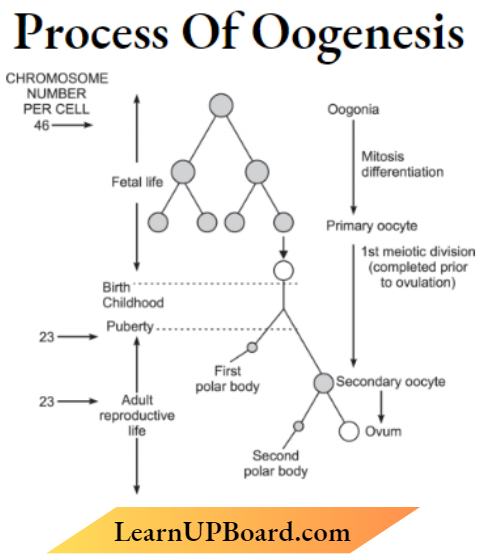
Question 6. Draw a diagrammatic sectional view of a seminiferous tubule (enlarged) in humans and label its parts.
Answer:
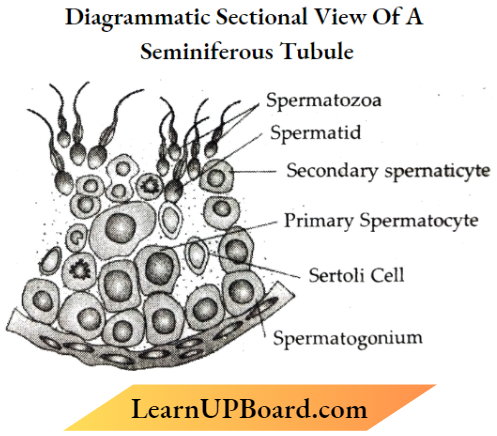
biology chapter 3
Question 7. Draw a diagram of a mature human sperm, label any three parts, and write their functions.
Answer:
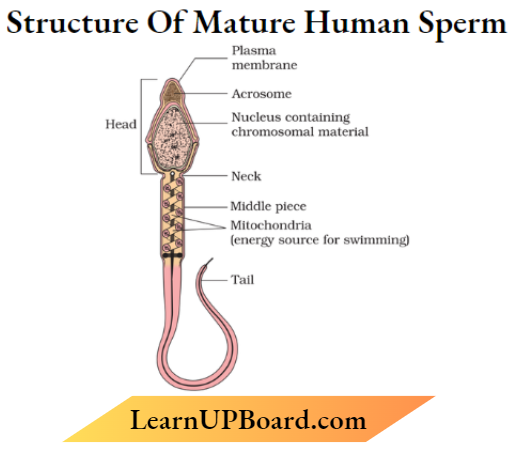
- Plasma membrane – Envelope of the sperm
- Acrosome – Filled with an enzyme that helps fertilization of the ovum
- Mitochondria – Energy source for swimming
- Middle Piece – Possess mitochondria which is the energy
- Tail – For movement of sperm
- Nucleus – Containing chromosomal material
Question 8. Medically it is advised to all young mothers that breastfeeding is the best for their newborn babies. Do you agree? Give reasons in support of your answer.
Answer:
Yes. it provides nutrition like calcium. fats, lactose, or provides passive immunity or antibodies like IgA
Question 9:
1. Draw a diagram of a sectional view of the human ovary and label
- Primary follicle
- Tertiary follicle
- Graafian follicle and
- Corpus luteum.
Answer: 1. Primary follicle

2. Write the function of the corpus luteum.
Answer:
- The corpus luteum secretes large amounts of progesterone which is essential for maintenance of the endometrium.
- Such an endometrium is necessary for the implantation of the fertilized ovum and other events of pregnancy.
- During pregnancy, all events of the menstrual cycle stop and there is no menstruation, in the absence of fertilization, the corpus luteum degenerates.
- This causes disintegration of the endometrium leading to menstruation, marking a new cycle.
Important Questions for Class 12 Biology Chapter 2 – Human Reproduction Long Question And Answers
Question 1. Study the figure given below of a human female reproductive tract showing the transport of the ovum, its fertilization, and the growing embryo moving through the fallopian tube and answer the questions that follow :
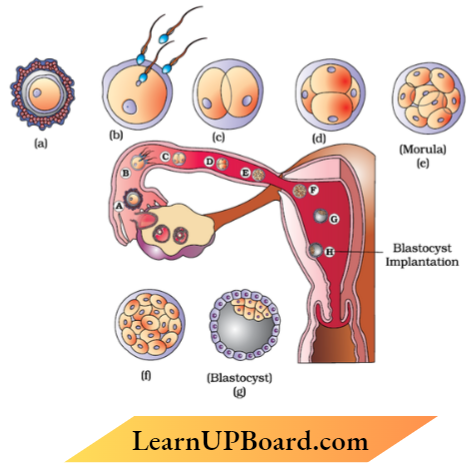
1. Identify the embryonic stages ‘e’ and ‘g’ and differentiate between them.
Answer:
e – Morula – The embryo with 8 to 16 blastomeres is called a morula.
g = Blastocyst – The morula continues to divide and transforms into blastocyst it has 32 cells.
2. Describe the process of implantation as shown in Figure H’
H- Implantation – The trophoblast layer then gets attached to the endometrium and the inner cell mass gets differentiated as the embryo. After attachment, the uterine cells divide rapidly and cover the blastocyst. As a result, the blastocyst becomes embedded in the endometrium of the uterus. This is called implantation and it leads to pregnancy.
Question 2:
1. Draw a sectional view of a human ovary and label the primary follicle, tertiary follicle, Graafian follicle, and corpus luteum in it.
Answer:

2. Name the gonadotropins and explain their role in oogenesis and the release of ova.
LH, FSH
Both Lit and F8H increase during the follicular phase and stimulate follicular development, as well as the secretion of estrogen by the growing follicles. LIT surge ( rapid secretion of LH) during mid-cycle or 14 days or induces rupture of Grafftan follicle and release of the ovary or secondary oocyte.
Question 3:
1. Describe the different stages of development a fertilized ovum in a human female undergoes up to the blastocyst stage.
Answer:
The zygote moves through the isthmus of the oviduct towards the uterus, and the mitotic division called cleavage begins, forming 2, 4, 8, and 16 daughter cells, called blastomeres, the embryo with 8 to 16 blastomeres is called a morula, the morula continues to divide and transforms into blastocyst.
2. Name the parts of a blastocyst and write the fate of these parts till the onset of pregnancy.
Answer:
- Trophoblast: Gets attached to the endometrium for implantation/helps in the formation of the placenta.
- Inner cell mass: The inner cell mass gets differentiated as the embryo.
Question 4.
1. Explain the events that occur in the uterus during the menstrual cycle in human females.
Answer:
- Menstrual Phase, the the endometrial lining of the uterus and the blood vessels are, in the Proliferative phase endometrium regenerates due to proliferation (this phase is under the influence of estrogen).
- The secretory phase is for the maintenance of the endometrium of the uterus to receive the embryo (this phase is under the influence of Progesterone).
2. What is parturition? Mention how it is induced.
Answer:
The process of delivery of the fetus (childbirth), is induced by a complex neuroendocrine mechanism.
Question 5.
1. Explain the menstrual cycle in human females.
Answer:
- Menstrual Phase – Menstrual flow occurs due to the breakdown of the endometrial lining of the uterus, when fertilization does not occur.
- Follicular Phase – Primary follicles grow into mature Graafian follicles and endometrium regenerates through proliferation, changes induced by pituitary and ovarian hormones.
- Ovulatory Phase – LH surge, induces rupture of Graafian follicle and release of secondary oocyte or ovum during the middle of the cycle (therefore 14th day).
- Luteal phase – Ruptured Graafian follicle transforms into corpus luteum which secrete a large amount of progesterone, essential for maintaining endometrium.
2. How can the scientific understanding of the menstrual cycle of human females help as a contraceptive measure?
Answer:
Because ovulation occurs during the mid-mid-cycle, chances of fertilization are very high so, couples should abstain from coitus between the 10th and 17th day.
Question 6.
1. Draw a diagram of the adult human female reproductive system and label the different :
- parts of the fallopian tube
- Layers of the uterus wall
Answer:
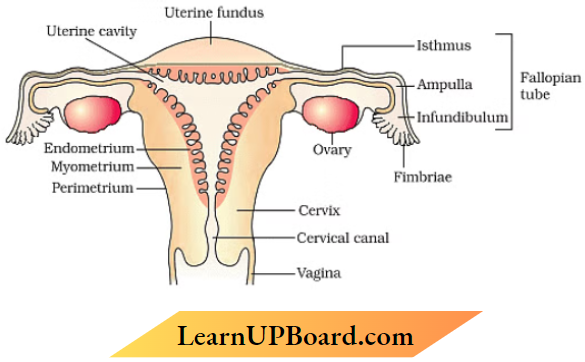
2. Explain the events during fertilization of an ovum in humans.
When a sperm comes in contact with Zona pellucida of the ovum this induces changes in the membrane that blocks entry of additional sperm. secretions of acrosome help sperm enter into the cytoplasm of the ovum through zona pellucida and plasma membrane, this I the completion of the meiotic division of secondary oocyte and formation of a haploid ootid/ovum (and a second polar body), haploid nucleus of ovum fuses with sperm nucleus to form a diploid zygote (fertilization occurs)
Question 7:
1. Explain the following phases in the menstrual cycle of a human female:
- Menstrual phase
- Follicular phase
- Luteal phase
Menstrual phase – First 3-5 days of the cycle where menstrual flow occurs due to the breakdown of the endometrial lining of the uterus, if the released ovum is not fertilized.
The follicular phase – From the 5th to the 14th day of the cycle where the primary follicles grow to become a fully mature Graafian follicle, and the endometrium of the uterus regenerates. Graafian follicle ruptures to release ova (ovulation on 14 th day)
Futeal Phase – During the 15thto 28th day remaining parts of the Graafian follicle transform into corpus luteum, and secretion of progesterone (essential for the maintenance of endometrium) All these phases are under the influence of varying concentrations of pituitary and ovarian hormone
2. A proper understanding of the menstrual cycle can help immensely in family planning. Do you agree with the statement? Provide reasons for your answer.
Answer:
Yes, can take appropriate precautions between the 10th and 7th day of t(a) Menstrual phase – first 3-5 days of the cycle where menstrual flow occurs due to break down of the endometrial lining of the uterus if the released ovum is not fertilized.
Class 12 Biology Chapter 13 Important Questions Biodiversity and Conservation
Class 12 Biology Chapter 13 Important Questions Biodiversity And Conservation Short Question And Answer
Question 1. State ‘two’ observations made by German naturalist, Alexender von Humboldt during his extensive explorations in South American jungles.
Answer:
Within a region species richness increases with increasing explored area but only up to a limit, this relation for a wide variety of taxa turns out to be a rectangular hyperbola.
Question 2. Identify the areas labeled 1, 2, 3, and 4 in the pie chart given below representing the biodiversity of plants showing their proportionate number of species of major taxa.
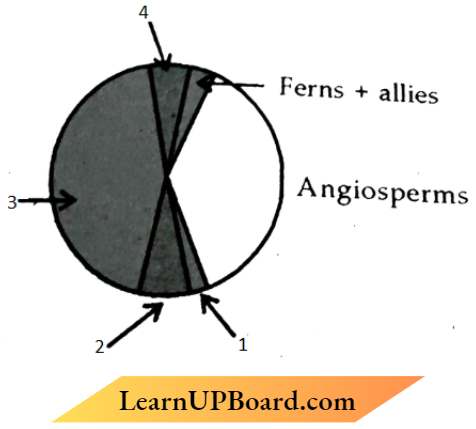
Answer:
- Lichen
- Algae
- Fungi
- Mosses
Question 3. Suggest two practices giving one example of each, that help protect rare or threatened species.
Answer:
- In situ conservation, biodiversity hotspots biosphere reserves, national parks or sanctuaries, or Ramsar sites or sacred groves.
- Ex situ conservation. Zoological parks botanical gardens wildlife safari parks cryopreservation techniques Tissue culture seed bank or pollen banks.
Read and Learn More Important Questions for Class 12 Biology Chapter Wise
Question 4.
1. Write the inference drawn by Alexander von Humboldt after his extensive exploration of the South American jungle.
Answer:
German naturalist and geographer Alexander von Humboldt observed that within a region species richness increased with increasing explored area, but only up to a limit.
2. Study the graph given below
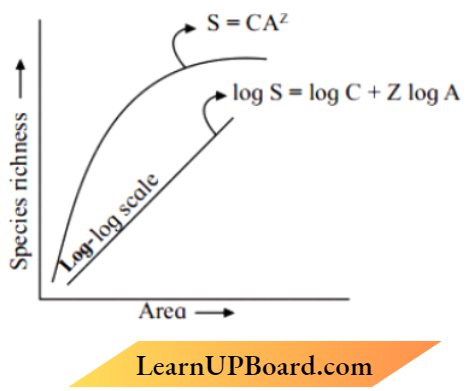
As per Alexander von Humboldt, what do the symbols S, A, Z, and C in the graph stand for, concerning a species and area relationship?
On a logarithmic scale, the relationship is a straight line described by the equation log S = log C + Z log A
where
S = Species richness A = Area
Z = Slope of the line (regression coefficient)
C = Y-intercept
Question 5.
1. Explain the concept of co-extinction by taking two examples.
Answer:
When a species becomes extinct, the plant and animal species associated with it in an obligator) way also become extinct Example: When a host fish species becomes extinct, its unique assemblage of parasites also meets the same fate. Another example is the case of a coevolved plant-pollinator mutualism where the extinction of one invariably leads to the extinction of the other.
2.”Forests provide intangible benefits to as.” Explain by taking three different areas, how.
Answer:
- Source of oxygen in the earth’s atmosphere,
- Pollination is another service provided by forests through different pollinators.
- Source of aesthetic pleasures (walking through thick woods or watching spring flowers in full bloom or waking up to Bulbul’s song in the morning),
- Humans derive countless economic benefits from nature – food (cereals, pulses, fruits),
- Source of firewood or fiber or construction material or industrial or industrial products (tannins or lubricants or dyes or resin perfumes).
Question 6. Study the pie chart given below, representing the global diversity: proportionate number of species of major taxa, and answer the following questions based on it.
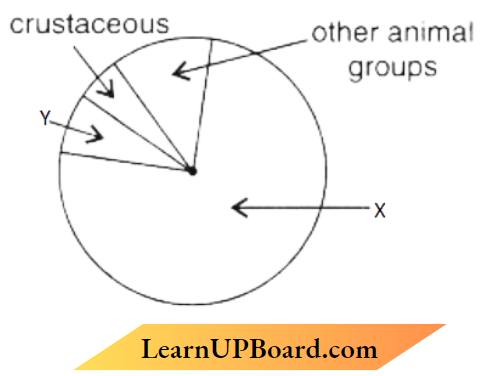
- Identify ‘X’ and ‘Y’ in the given pie chart.
- Which one of the two, ‘X’ is the most species-rich taxonomic group, and by what percentage?
Answer:
X – Insects
Y – Molluscs
Among animals insects are the most species-rich taxonomic group, making up more than 70 percent of the total. That means, out of every 10 animals on this planet. 7 are insects.
Question 7. How have the following factors affected the biodiversity of an area? Explain.
- Habitat loss and fragmentation
- Over-exploitation
Answer:
- Habitat loss and fragmentation: This is the most important cause driving animals and plants to extinction. The most dramatic examples of habitat: loss come from tropical rainforests. The rainforests now cover no more than 6 percent. They are being destroyed fast and 1000 more hectares of rainforest would have been lost. The Amazon rain forest (‘lungs of the planet’) harboring probably millions of species is being cut and cleared for cultivating soya beans or for conversion to grasslands for raising beef cattle. Besides total loss, the degradation of many habitats by pollution also threatens the survival of many species, and certain animals with migratory habits are badly affected, leading’ population declines,
- Over-exploitation: Humans have always depended on nature for food and shelter, but when “need’ turns to ‘greed’, it leads to the over-exploitation of natural resources. Many species extinctions in the last 500 years (Steller’s sea cow, passenger pigeon) were due to overexploitation by humans. Presently many marine fish populations around the world are over-harvested, endangering the continued existence of some commercially important species.
Question 8. Study the graphical representation of Species richness – Area relationship is given below and answer the questions that follow :

1. What do S, C, Z, and A represent in the given graph?
Answer:
S = Species richness, A = Area,
Z = slope of the line (regression coefficient)
C = Y-intercept
2. What will be the range value of the ‘Z line’ if we analyze the species-area relationship among very large areas like the entire continent?
Z values in the range of 0.6 to 1.2
Question 9. Alien species invasion has been a threat to biodiversity. Justify with the help of a suitable example. List any other three causes responsible for such a loss.
Answer:
Example of Alien species invasion
- Nile Perch, introduced into Lake Victoria( in East Africa), led to the extinction of Cichlid fish (more than 200 species) in the lake
- Introduction of African catfish (Clarias gariepinus), for aquaculture, posing a threat to indigenous catfish
- Introduction of carrot grass (Parthcnium) Lantaua or Water hyacinth (lucrhornia), which are invasive weeds, that pose a threat to native species or any other appropriate example.
Causes of biodiversity loss
- Habitat loss and fragmentation
- Overexploitation
- Co-extinction
Question 10. Tigers inhabit forests. Over the past many decades, the tiger population has been on the decline in our country. A project ‘Save Tiger’ was launched in 1973 to conserve this precious species. It is heartening to see in the last couple of decades that there has been a gradual increase in the tiger population in our country.
Answer the questions :
1. Mention one major cause responsible for the decline in tiger population.
Answer:
Habitat loss and fragmentation or prey depletion.
2. Write one main effort of the biodiversity conservationists that must have helped in the increase in tiger population.
Answer:
Through in situ conservation like national parks or wildlife sanctuaries protect biodiversity hot spots or biosphere reserves or ex-situ conservation like zoological parks or zoos wildlife safari parks or cryopreservation,
3. State how it is possible to count the number of tigers in a forest area.
Answer:
Based on pug marks / faecal pellets/sites with scratches on trees chosen for installing camera/sinee each tiger has a very unique stripe pattern hence this is used to differentiate one tiger from the other.
Question 11. Analyze the effects of ‘Alien species invasion’ on the biodiversity of a given area. Provide two examples.
Answer:
- Introduction of alien species causes the decline or extinction of indigenous species due to tough home-tuition for utilization of resources Examples:
- The introduction of Nile perch in Lake Victoria led to the extinction of more than 200 species of Cichlid fish and the introduction of African catfish (Clarias) for aquaculture poses a threat to indigenous catfish.
- The threat posed to native species by invasive exotic weeds like carrot grass (Parthcnium)lantana and water hyacinth (Eichhornia) or Extinction of Abingdon tortoise by the introduction of goat, (any two).
Question 12. Explain the ‘Ex-situ conservation’ of Biodiversity. How is the in-situ conservation different from it?
Answer:
- Ex-site – Threatened animals and plants are taken out from their natural habitat and placed in special settings where they can be protected and given special care, by keeping the gametes of threatened species preserved in viable and fertile conditions for a long time.
- Zoological parks botanical gardens wildlife safari parks cryopreservation or eggs can be fertilized in-vitro or tissue culture method/seed banks.
- In-situ conservation, organisms are given protection in their natural habitat in which biodiversity is protected at all levels.
Class 12 Biology Chapter 13 Important Questions Biodiversity And Conservation Long Question And Answers
Question 1.
1. Identify the features of a stable biological community.
Answer:
- A stable community should not show too much variation in productivity from year to year.
- It must be either resistant or resilient to occasional disturbances (natural or man-made)
- It must also be resistant to invasions by alien species.
2. How did David Tilman’s findings link the stability of a biological community to its species richness?
Answer:
Plots with more species showed less year-to-year variation in total biomass increased diversity contributed to higher productivity.
Question 2.
1.”India has greater ecosystem diversity than Norway.” Do you agree with the statement? Give reasons in support of your answer.
Answer:
Yes
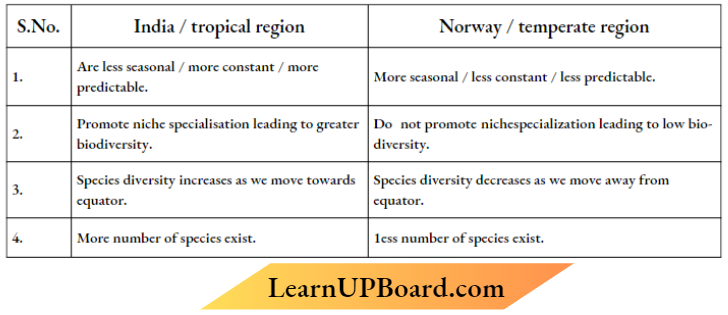
2. Write the difference between genetic biodiversity and species biodiversity that exists at all levels of biological organization.
Answer:
Genetic diversity – Diversity or variation within a species over its distributional range example, 1000 vanities of mango in India.
Species diversity – Diversity or variation at a species level example, Amphibian diversity in the western ghat.
Important Questions for Class 12 Biology Chapter 12 – Ecosystem
Important Questions for Class 12 Biology Chapter 12 – Ecosystem Very Short Question And Answers
Question 1. In the illustration given below of a simplified food web on an island, the arrows indicate the direction of energy How and the Roman numbers indicate species within the food web?
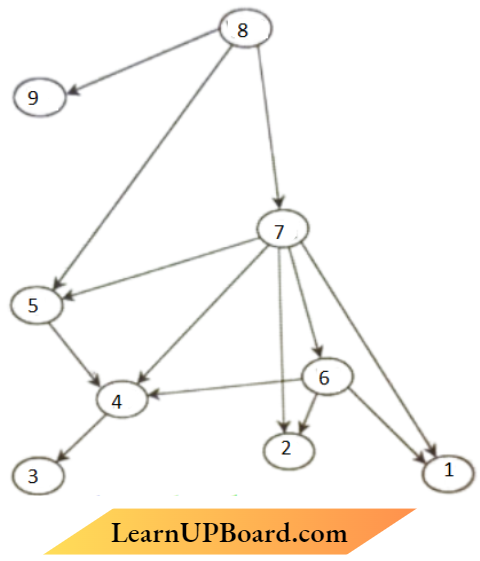
ecosystems questions and answers
At which trophic level or levels does species VIII function?
- 2″d and 3″J consumer
- P consumer
- Producer
- 3, a and 4’1′ consumer
Answer: 3. Produce
Important Questions for Class 12 Biology Chapter 12 – Ecosystem Short Question And Answers
Question 1. Explain reasons why the pyramid of energy is always upright.
Answer:
- The pyramid of energy is always upright because in an ecosystem the energy flow is always unidirectional, when energy flows from a trophic level to the next level, some energy is always lost to the atmosphere in the form of heat& never goes back to the sun
- There is a gradual decrease in energy at successive trophic levels, this happens according to the 10% law of energy transfer, where only 10% of total energy is transferred from one to the next level, the energy is highest at the producer level and it gradually decreases on moving from producer to top carnivore.
“questions about ecosystem with answers “
Read and Learn More Important Questions for Class 12 Biology Chapter Wise
Question 2. Describe the inter-relationship between productivity, gross primary productivity, and net productivity.
Answer:
- Productivity is the rate of biomass production per unit area over some time.
- Gross primary productivity is the rate of production of organic matter during photosynthesis in an ecosystem and Net productivity is the gross primary productivity minus respiration losses (R).
GPP – R = NPP
Important Questions for Class 12 Biology Chapter 12 – Ecosystem Long Question And Answers
Question 1.
1. Construct a pyramid of biomass of the grassland ecosystem. How is the pyramid of biomass in the sea different from it?
Answer: Pyramids of biomass in grassland ecosystem – upright, Pyramid of biomass in the sea – (generally)inverted.
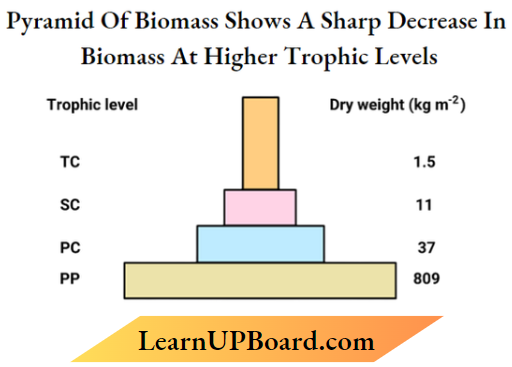
“ecosystem question answer “
2. Name the primary producer and primary consumer in the sea.
Answer:
- Primary producers – phytoplankton.
- Primary consumers – fishes or zooplankton.
3. What is a standing crop?
Answer: Each trophic level has a certain mass of living material at a particular time called the standing crop.
Question 2.
1. What does an ecological pyramid represent? State any two limitations that these pyramids have.
Answer:
- Ecological pyramids represent the relationship between different trophic levels in terms of number, biomass, or energy Limitations of the pyramid:
- It does not take into account the same species belonging to two or more trophic levels. It assumes a single food chain which rarely exists in nature.
- It does not accommodate a food web or Saprophytes are not given any place even though they play a vital role in the ecosystem.
“ecosystem questions “
Question 2. Describe an inverted pyramid of biomass with the help of an example.
Answer: The pyramids of biomass in aquatic ecosystems or sea are generally inverted example biomass of fish is much more than the biomass of phytoplanktons.
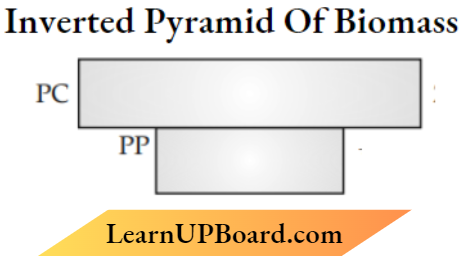
Question 3.
1. What is a trophic level in an ecosystem? What is a ‘standing crop’ concerning it?
Answer: The specific place of an organism in a food chain, the mass of living material (biomass) at each trophic level at a particular time.
2. Explain the role of the ‘first trophic level’ in an ecosystem.
Answer: The first trophic level has producers or autotrophs. which traps solar energy to produce food (photosynthesis).
3. How is the detritus food chain connected with the grazing food chain in a natural ecosystem?
Answer:
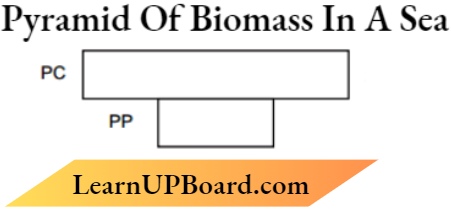
“questions for ecology “
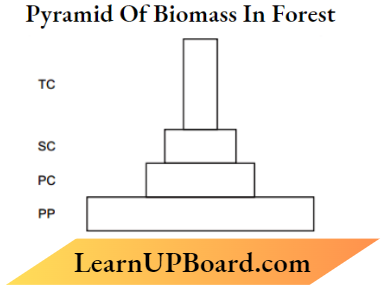
Organisms of the Detritus food chain (DFC) are the prey to the Grazing food chain (GFC) organism, the dead remains of GFC are decomposed into simple inorganic materials which are absorbed by DFC organisms.
Question 4. Draw the pyramids of biomass in the sea and a forest. Explain giving reasons why are the two pyramids different.
Answer:
- Sea – Inverted. because the biomass of fish or other aquatic animals exceeds that of phytoplankton or a small standing crop of phytoplankton supports a large standing crop of zooplankton.
- Forest – Upright. because the biomass of producers exceeds that of herbivores or carnivores or allows a sharp decrease in biomass at higher trophic levels.
Question 5.
1. What is an ecological pyramid? Compare the pyramids of energy, biomass, and numbers.
Answer:
Graphical representation of the relationship among the organisms at different trophic levels
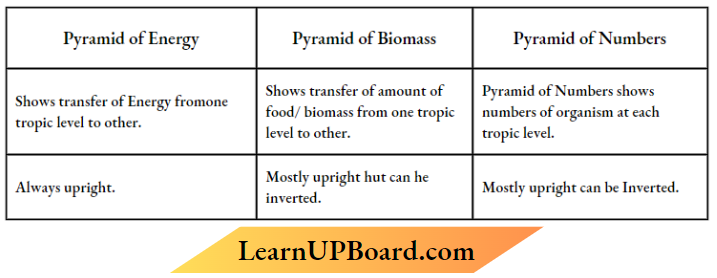
“ecosystem bank of biology “
2. Write any two limitations of ecological pyramids.
Answer: It does not accommodate the food web and does not take into account the same species belonging to two or more tropic levels. Saprophytes are not given any place.
Question 6.
1. Comment on the pattern in which all communities undergo a change in composition and structure with changing environmental conditions.
Answer:
- All communities are that their composition and structure constantly change in response to the changing environmental conditions.
- This change is orderly and sequential, parallel with the changes in the physical environment.
- These changes lead finally to a community that is in near equilibrium with the environmental aid that is called a climax community.
- The gradual and fairly predictable change in the species composition of a given area is called ecological succession.
- During succession, some species colonize an area and their population becomes more numerous whereas populations of other species decline and even disappear.
2. Explain ‘Climax community’ and ‘sere’.
Answer:
- A community that is in near equilibrium with the environment is called a climax community.
- The entire sequence of communities that successively change in a given area is called sere(s).
“class 12 bio ecosystem notes “
3. Differentiate between primary and secondary succession with examples.
Answer:
- In primary succession in water, the pioneers are the small phytoplanktons, which are replaced with time by rooted-submerged plants, rooted-floating angiosperms followed by free-floating plants, then reed-swamp, marsh-meadow, scrub, and finally the trees.
- The climax again would be a forest. With time the water body is converted into land.
- In secondary succession the species that invade depend on the condition of the soil, availability of water, the environment as also the seeds or other propagates present.
- Since soil is already there, the rate of succession is much faster, and hence, climax is also reached more quickly.
Important Questions for Class 12 Biology Chapter 11- Organisms and Populations
Important Questions for Class 12 Biology Chapter 11- Organisms And Populations Very Short Questions and Answers
Question 1. Win do cattle and goats generally not browse on Caiotropis plants growing in an abandoned field? Give any one reason.
Answer: Caiotropis produces highly poisonous cardiac glycosides so cattle or goats never browse on this plant.
OR
Give two reasons as to why a weed such as Caiotropis flourishes in abandoned fields,
Answer: Dry hairy seeds help in dissemination or are not grazed by animals as they produce poisonous substances.
Important Questions for Class 12 Biology Chapter 11- Organisms And PopulationsShort Question And Answers
Question 1.
1. Observe the schematic representation given above and answer the following questions :
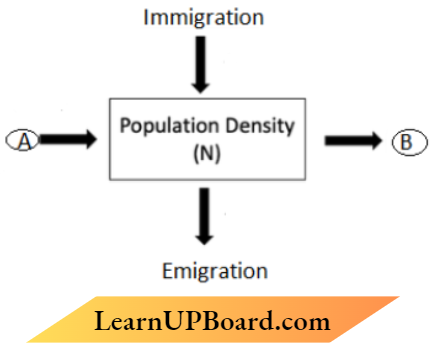
biology most important questions
- Identify A and B.
- Calculate the growth rate of bacteria in a curd sample, where I million bacteria increased to two million, within one hour.
Answer: A – Mortality B – Natality
The per cent growth or birth rate per individual
- A – Mortality B – Natality
- The per cent growth or birth rate per individual
= \(\frac{\text { Final population }- \text { Initial population }}{\text { Initial population }} \times 100\)
= \( \frac{2 \text { Million }-1 \text { Million }}{1 \text { Million }} \times 100\)
= \(\frac{1}{1} \times 100=100 \%\)
Read and Learn More Important Questions for Class 12 Biology Chapter Wise
2. Identify the type of pyramid given above. Write (lie identifying feature based on which of you identified it.
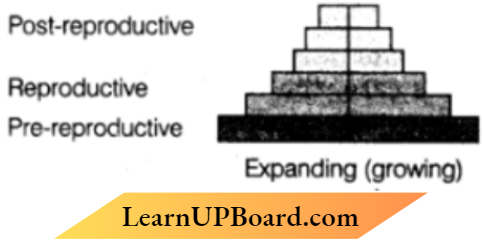
Answer: The given pyramid is expanding. The population of pre-reproductive is higher than the post-reproductive population, which makes the expanding pyramid of population.
Question 2. Explain the pollination mechanism involved in the co-evolution of the two species, namely Ophrys (orchid) and its insect pollinator bees (& bumble bees).
Answer:
- Orchids show a bewildering diversity of floral patterns many of which have evolved to attract the right pollinator insect (bees and bumblebees) and ensure guaranteed pollination by it
- The Mediterranean orchid Ophrys employs ‘sexual deceit’ to get pollination done by a species of bee. One petal of its flower bears an uncanny resemblance to the female of the bee in size, colour and markings.
- The male bee is attracted to what it perceives as a female, ‘pseudocopulates’ with the flower, and during that process is dusted with pollen from the flower When this same bee pseudocopulates’ with another flower, it transfers pollen to it and thus, pollinates the flower, so we can see how co-evolution operates.
- If the female bee’s colour patterns change even slightly for any reason during evolution, pollination success will be reduced unless the orchid flower co-evolves to maintain the resemblance of its petal to the female bee
“important topics of biology class 12 “
Question 3.Given below an equation describing the growth pattern of a population: dN/dt = rN
- Mention the type of growth in the model or growth pattern of the population described by the given equation.
- What does V in the equation signify?
- Mention the type of growth curve that will be obtained if the population density (N) is plotted against time (t).
- According to you, will the resource availability be limited or unlimited for (his type of growth in a given population?
Answer:
- Exponential growth
- The r in this equation is called the ‘intrinsic rate of natural increase’
- Logistic Growth Curve
- The resource availability will be limited for this type of growth in a given population
Question 4. Describe the two basic processes which contribute to an increase in the population density of an area.
Answer:
Natality and Immigration contribute to an increase in population density.
- Natality refers to the number of births during a given period in the population that are added to the initial density.
- Immigration is the number of individuals of fee same that have come into the habitat from elsewhere during the period under consideration.
Question 5. Explain commensalism with the help of an example from the animal world.
Answer: Commensalism is the interaction in which one species benefits and the other is neither harmed nor benefited.
- An example of commensalism is the interaction between a sea anemone that has stinging tentacles and the clown fish that lives among them.
- The fish gets protection from predators which stay away from the stinging tentacles. The anemone does not appear to derive any benefit from hosting the clownfish.
“class 12 biology chapter 2 important questions pdf download “
Question 6. Why do some organisms enter into diapause while some others into aestivation? Give one example of each of such organisms.
Answer:
- Diapause: To avoid unfavourable conditions, Example-Zooplankton
- Aestivation: To avoid summer-related problems or to avoid heat/desiccation, for Example, Snail Fish.
Question 7. If in a population of size ‘N’, the birth rate is represented as it and the death rate as ‘d’ the increase or decrease in ‘N’ during a unit period ‘t’ will he :
⇒\(\frac{d N}{d T}=(b-d) \times N\)
The equation given above can also be represented as :
⇒\(\frac{d N}{d T}=r \times N\)
What does V represent? Write any one significance of calculating V for any population.
Answer:
r = intrinsic rate of natural increase, it is an important parameter for assessing the impacts of any biotic or abiotic factor on population growth.
Question 8. Explain (the role played by predators in a community.
Answer:
- Acting as ‘conduits’ for energy transfer across trophic levels, predators play important roles. They keep prey populations under control.
- Predators also help in maintaining species diversity in a community, by reducing the intensity of competition among competing prey species.
previous year question paper class 12 biology chapter wise
Question 9. Explain the difference between commensalism and mutualism types of interactions, with the help of a suitable example of each.
Answer:
- Mutualism – Both the interacting species are benefitted example Uehen or Mycorrhizae or Fig And Wasp
- Commensalism – One species benefits and the other does not benefit from loss example orchid gunving on a mango branch or a barnacle on the back of a whale or cattle egret And grazing cattle.
Question 10. The graph given below shows the different types of growth curves of different species.
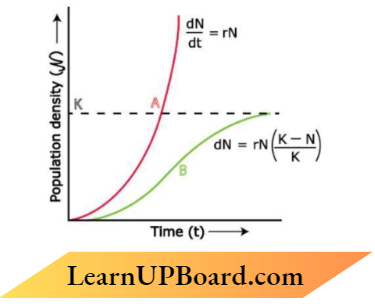
Answer the questions :
- Name the type of growth curve ‘as shown in the graph.
- State one reason the growth equation ‘b’ is said to be logistic.
- what is ‘K’ representing in the equation ⇒\(\frac{\mathrm{dN}}{\mathrm{dt}}=\mathrm{rN}\left[\frac{\mathrm{K}-\mathrm{N}}{\mathrm{K}}\right]\) given along the logistic curve?
Answer:
- Exponential or geometries or T-shaped
- Resources for the growth of most animal populations are finite and become limiting sooner or later
- Carrying capacity.
Question 11. Differentiate between an ’Expanding age pyramid’ and a ’Stable age pyramid’. Substantiate your answer with diagrams.
Answer:
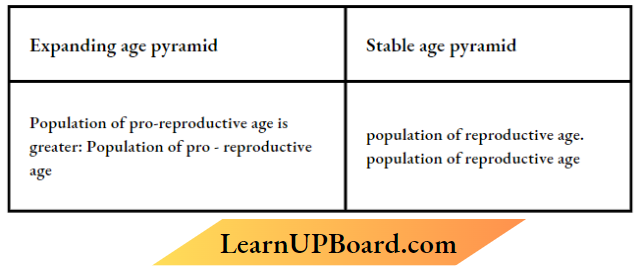
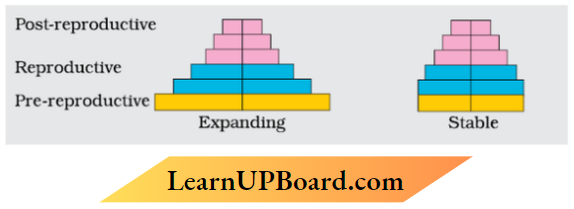
Question 12. Explain with the help of an example each any three ways the ecologists use to measure the population density of different organisms rather than by calculating their absolute number.
Answer:
- By measuring the per cent cover or biomass which may be more meaningful, in cases like in an area where a large number of Parthenium is there but only one banyan tree densities of microorganisms in a culture medium ”
- Measuring relative densities instead of absolute densities of organisms, eg the number of fish caught per trap in a lake is good enough to estimate population size.
By estimating the population size indirectly without actually seeing or counting them, e.g counting tiger population in national parks based on their pug marks or faecal pellets
“12th biology important questions 2023 “
Question 13. Explain the logistic growth pattern of a population. Why do population growth patterns of all organisms ultimately follow it?
Answer:
- A population growing in a habitat with limited resources, shows a lag phase, followed by phases of acceleration and deceleration and finally an asymptote when the population density reaches the carrying capacity,.
- A plot of population density about time results in sigmoid curve Since resources for growth of most organisms are finite, and become limiting sooner or later the logistic growth pattern is ultimately followed.
Question 14. Explain with the help of two examples how certain plants have evolved morphological and chemical defences against primary consumers such as cows and goats.
Answer:
Plants have evolved an astonishing variety of morphological and chemical defences against herbivores.
- Thorns (Acacia, Cactus)are the most common morphological means of defence Many plants produce and store chemicals that make the herbivore sick when they are eaten, inhibit feeding or digestion, disrupt its reproduction or even kill it.
- You must have seen the weed Caloiropisgrowing in abandoned fields The plant produces highly poisonous cardiac glycosides and that is why you never see any cattle or goats browsing on this plant.
- A wide variety of chemical substances that we extract from plants on a commercial scale (nicotine, caffeine, quinine, strychnine, opium, etc.) are produced by them actually as defences against grazers and browsers
Important Questions for Class 12 Biology Chapter 11- Organisms and Populations Long Question And Answers
Question 1. Study the age pyramids; A’, ‘B’ and ‘c’ Of the human population given below the questions that follow :

- Identify pyramids ‘B’ and ‘C’
- Write the basis on which the above pyramids are plotted.
Answer:
- B-Stable population
- C- Declining population
- Age Distribution of male and female human population
Question 2.
1. Compare, giving reasons, the (J-shaped and S-shaped) models of population growth of a species.
Answer:
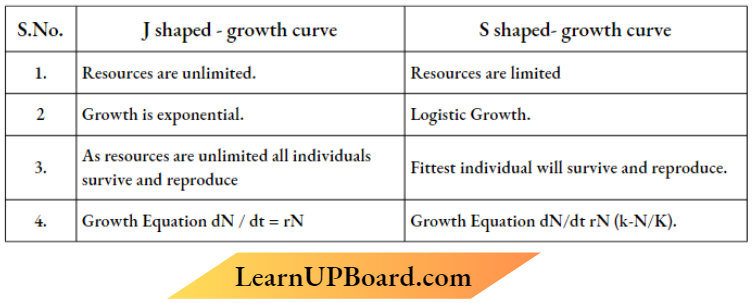
Question 3. Explain “fitness of a species” as mentioned by Darw in.
Answer: When resources are limited. Competition occurs between individuals, the fittest will survive, and reproduce to leave more progeny
Important Questions for Class 12 Biology Chapter 11- Organisms and Populations Case Study-Based Question And Answers
Question 1. Read the following passage and answer any four questions from 1 to 5.
- Acacia plants are particularly common in drier tropical and subtropical environments in the world.
- The swollen thorn acacias, form obligate mutualisms with Pseudomyrmex.
- A species of ants restricted to the New World Swollen thorn acacias show several characteristics related to their obligate association with ants, including enlarged thorns with a soft, easily excavated pith; year-round leaf production, enlarged foliar nectaries; and leaflet tips modified into concentrated food sources called Beltian bodies.
- The thorns provide living space, while the foliar nectaries provide a source of sugar and liquid.
- Beltian bodies are a source of oils and protein. Resident ants vigorously guard these resources against encroachment by nearly all comers, including other plants.
1. The association between the genus of Acaci and species of ants depict population interactions, known as :
- Competition
- Amensalism
- Mutualism
- Predation
Answer: 1. Mutualism
“important topics of biology class 12 “
2. In exchange for food and shelter, ants protect Acacias from the attacks of:
- Fungi
- Bacteria
- Herbivores
- Carnivores
Answer: 3. Herbivores
3. The above interaction suggests that the relationship between the two species is an example of:
- Competitive release
- Competitive exclusion
- Co-evolution
- Resource partitioning
Answer: 3. Co-evolution
4. The removal of resident ants from the Acacias will lead to :
- Reduced growth of Acacias
- Increased growth of Acacias
- Reduced population of ant species
- Increased population of ant species
Choose the correct alternative from the above statements :
- Only 1 is true
- 1 and 3 are true
- 3 and 4 are true
- 1 and 4 are true
Answer: 2. 1 and 3 are true
5. Given below is a graphical representation of ants and the Acacia shoots with an abundance of herbivorous insects :
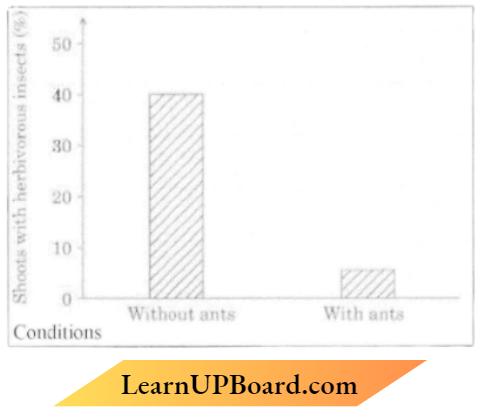
The conclusion drawn from the above data is :
- Acacia shoots will have higher rates of growth with resident ant species.
- Acacia shoots will have a neutral effect on growth with or without resident ant species
- Acacia shoots will have higher rates of growth without resident ant species.
- Growth of Acacia shoots is independent of resident ant species
Answer: 3. Acacia shoots will have higher rates of growth without resident ant species.
Biotechnology and its Applications Class 12 Important Questions and Answers Biology Chapter 10
Important Questions For Class 12 Biology Chapter 10 Biotechnology And its Applications Very Short Questions And Answers
Question 1. Nematode Specific Genes were introduced into the tobacco host plant using a vector
- pBR322
- Plasmid
- Bacteriophage
- Agrobacterium
Answer: 4. Agrobacterium
Question 2. ‘Cry genes’ that code for insecticidal toxins are present in
- Cotton bollworms
- Nematodes
- Corn borer
- Bacillus
Answer: 4. Bacillus thuringiensis
biology most important questions
Question 3. Mention the chemical change that pro-insulin undergoes, to be able to act as mature insulin.
Answer: Removal of C – peptide (from pro-insulin)
Question 4. What are Cry genes? In which organism are they present H
Answer: The genes that code for lit toxin Cry proteins or toxic proteins are present in Bacillus thingies
Read and Learn More Important Questions for Class 12 Biology Chapter Wise
Important Questions For Class 12 Biology Chapter 10 Biotechnology And its Applications
Short Question And Answers
Question 1. Name the Indian crop variety for which in 1997 an American company got a patent right through the IS Patent and Trademark Office. Why did the company claim it to be an invention or a novelty?
Answer:
- An American company got patent rights on Basmati rice through the US Patent and Trademark Office.
- This allowed the company to sell a ‘new’ variety of Basmati in the US and abroad
- This ‘new’ variety of Basmati had been derived from Indian farmer’s varieties. Indian Basmati was crossed with semi-dwarf varieties and claimed as an invention or a novelty.
Question 2. Name one toxin gene isolated from B.thuringiensis and its target pest.
Answer: Toxin gene crvlAc cell Ab targets pest-cotton Bol 1 worm crylAb, controls corn borer
OR
Why does the toxin produced by B.thuringiemis not kill the Bacillus?
Answer: Bt Toxin protein exists as inactive protoxins, the inactive toxin is converted into an active form of toxin only in the presence of the alkaline pH which is not available in the Bacillus.
Question 3. What are cry proteins? With the help of a suitable example, explain how it acts as a biological pesticide.
Answer:
- Cry Protein The insecticidal protein which is produced by the soil bacterium Bacillus thuringiensis is called cry protein
- For example, proteins encoded by the genes cryl.Ac and cryllAb control the cotton bollworms. The club controls corn borer.
reproduction in flowering plants questions and answers pdf class 12
Question 4.
1. One of the potential uses of genetic engineering is in the correction of a gene defect that has been diagnosed in a child or embryo, Explain how gene therapy is of help in ADA deficiency.
Answer:
- Gene therapy is a collection of methods that allows the correction of a gene defect that has been diagnosed in a child or embryo. Here genes are inserted into a person’s cells and tissues to treat a disease. Correction of a genetic defect involves the delivery of a normal gene into the individual or embryo to take over the function of and compensate for the non-functional gene.
- The disorder is caused due to the deletion of the gene for adenosine deaminase. In some children ADA deficiency can be cured by bone marrow transplantation: in others, it can be treated by enzyme replacement therapy, in which functional ADA is given to tire patients by injection. However, the problem with both of these approaches is that they are not completely curative.
- As a first step towards gene therapy, lymphocytes from the blood of the patient are grown in a culture outside the body A functional ADA cDNA (using a retroviral vector) is then introduced into these lymphocytes, which are subsequently returned to the patient, as these cells are not immortal, the patient requires a periodic infusion of such genetically engineered lymphocytes, if the gene isolated from marrow cells producing ADA is introduced into cells at early embryonic stages, it could be a permanent cure
2. A schematic diagram of matured human insulin is given below :
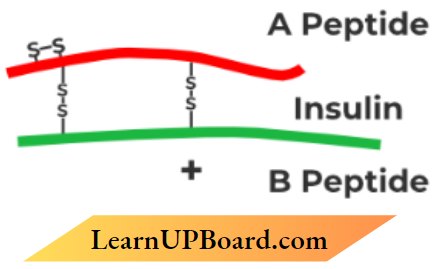
How is the process of its formation naturally in the human body different from that of its formation by rDNA technology? Explain,
- Insulin consists of two short polypeptide chains: chain A and chain B, that are linked together by disulfide bridges In mammals, including humans, insulin is synthesized as a pro-hormone which contains an extra stretch called the C peptide.
- This peptide is not present in the mature insulin and is removed during maturation into insulin. The main challenge for the production of insulin using rDNA techniques was getting insulin assembled into a mature form.
- Eli Lilly an American company prepared two DNA sequences corresponding to A and B, chains of human insulin, and introduced them in plasmids to produce insulin chains.
- Chains A and B were produced separately, extracted, and combined by creating disulfide bonds to form human insu1in
Question 5. What are transgenic animals? How are they being used for vaccine safety and chemical safety testing? Explain.
Answer:
Transgenic animals: Animals that have had their DNA manipulated to possess and express an extra or foreign or transgene.
- Transgenic mice are being developed for use in testing the safety of the vaccine before they are used in humans or transgenic mice are being used to test the safety of the polio vaccine, if successful and found reliable they could replace the use of monkeys to test the safety of batches of the vaccine.
- Transgenic animals are made that carry genes that make them more sensitive to toxic substances than non-transgenic animals, they are exposed to the toxic substances, and the effects are studied (which allows to obtain results in less time)
class 12 biology chapter 2 important questions and answers
Question 6. A child is born with ADA-deficiency
- Suggest an ex-phi in a procedure for a possible life-long (permanent) cure.
- Name any other possible treatment for this disease.
Answer:
- In gene therapy, lymphocytes from the blood of a patient are grown in a culture outside the body, functional ADA cDNA is introduced into these lymphocytes, and these cells are returned to the patient’s body at an early embryonic stage.
- Bone marrow transplantation, enzyme replacement therapy
Question 7. How has the use of agrobacterium as vectors helped in controlling Meloidegyne incognita infestation in tobacco plants? Explain in the correct sequence.
Answer:
- Using the Agrohucteriwti vector nematode specific genes are introduced into the host plant.
- Sense and antisense strands of mRNA are produced.
- ds RNA is formed.
- ds RNA initiates RNAi
- Prevents translation of mRNA or silencing of mRNA of parasite or nematode.
- The parasite will not survive.
Question 8.
- What are transgenic animals?
- Name the transgenic animal having the largest number amongst all the existing transgenic animals.
- Mention any three purposes for which these animals are produced.
Answer:
- Animals that have had their DNA manipulated to possess and express an extra/foreign gene
- Mice
- Normal physiology and development
- Study of disease.
- Biological products
- Vaccine safety
- Chemical safety testing
Question 9. Explain the various steps involved in the production of artificial insulin.
Answer: Two DNA sequences corresponding to A and B polypeptide chains of human insulin were prepared, and these were introduced into Kco/I to produce A and B chains separately, these chains were extracted and combined by creating disulfide bonds.
previous year board questions chapter wise class 12 pdf
Question 10. What was the challenge for the production of insulin using rDNA techniques? How did Eli Lilly produce insulin using rDNA technology?
OR
Explain how Eli Lilly, an American company produced insulin by recombinant DNA technology.
Answer:
- In mammals, including humans, insulin is synthesized as a pro-hormone which contains an extra stretch called the C peptide. This C peptide is not present in the mature insulin and is removed during maturation into insulin.
- The main challenge for the production of insulin using rDNA techniques was getting insulin assembled into a mature form. In 1983, Eli Lilly an American company prepared two DN A sequences corresponding to A and B, chains of human insulin, and introduced them in plasmids of Jf.coli to produce insulin chains.
- Chains A and B were produced separately, extracted, and combined by creating disulfide bonds to form human insulin.
Question 11. Name the organism from which the ‘cry’ genes are isolated. Mention with the help of suitable examples why and how bio-technologists have made use of ‘cry’ genes.
Answer:
- Bt toxin genes were isolated from Bacillus t and incorporated into several crop plants such as cotton. The choice of genes depends upon the crop and the targeted pest, as most – Bt toxins are insect-group sped tic.
- The toxin is coded by a gene crylAc named cry. There are a number of them, for example, the proteins encoded by the genes crylAc and cryllAb control the cotton bollworms, and that of crylAb controls corn borer.
- B. thingie misforms protein cn stats during a particular phase of their growth. These crystals contain a toxic insecticidal protein. The Bt toxin protein exists as inactive protoxins but once an insect ingests the inactive toxin, it is converted into an active form of toxin due to the alkaline pH of the gut which solubilises the crystals.
The activated toxin binds to the surface of midgut epithelial cells and creates pores. that cause cell swelling and lysis and eventually cause the death of the insect.
Important Questions For Class 12 Biology Chapter 10 Biotechnology And its Applications Long Question And Answers
Question 1. Read the following paragraph and answer the questions that follow :
Biotechnology revolves around the “gene of interest”, to open various avenues for human welfare in health, medicine pharma, agriculture etc, using different techniques, tools, and processes. One of the breakthroughs of biotechnology in medicine is the gene therapy.
- Name the human disease for which gene therapy was used for the first time.
- Explain the steps of gene therapy carried out to cure (the disease using the lymphocytes of (lie patient. Why is (his therapy not a permanent cure for the disease?
- Write the possible permanent cure of the disease by the gene therapy that is in progress.
Answer:
- ADA deficiency
- As a first step towards gene therapy. lymphocytes from the blood of the patient are grown in a culture outside the body. A functional ADA cDNA (using a “retroviral vector) is then introduced into these lymphocytes, which are subsequently returned to the patient. However, as these cells are not immortal, the patient requires periodic infusion of such genetically engineered lymphocytes.
- If the gene isolated from marrow cells producing ADA is introduced into cells at early embryonic stages, it could be a permanent cure.
Question 2.RINA interference (RNAi) holds great potential as a therapeutic agent for the treatment of human diseases and as a biocontrol agent for controlling pests in the field of agriculture.
Answer:
- The graph given below illustrates the use of RNAi for the potential treatment of disorders of cholesterol metabolism. Some people possess genetic mutations with elevated levels of the ‘ApoB’ gene which predisposes them to coronary artery diseases Lowering the amount of’ApoB’ can reduce the number of lipoproteins and lower the blood cholesterol.
- Tracy Zimmerman and her colleagues used RNAi in 2006 to reduce the level of of’ApoB’ in non-human primates Cynomofgus monkeys One group of monkeys was given RNAi treatment (Small interfering RNAs. siRNAs) (doses mg/kg siRNAs), a second group of monkeys were given RNAi treatment (doses 2.5 mg/kg siRNAs) and a third group of monkeys were injected with saline as control
The results of the experiments are illustrated in the graph given below :
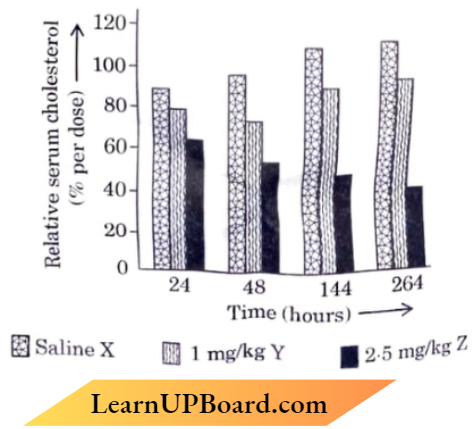
human reproduction class 12 important questions pdf
1. Write your interpretation from the bars X and Z obtained after 264 hours of treatment of monkeys with saline and 2.5 night siRNAs treatment respectively, in comparison to the bars obtained after 24 hours of treatment with saline and 2.5 mg/kg siRNAs.
Answer:
- Lowering the amount of’ApoB’ can reduce the number of lipoproteins and lower the blood cholesterol. According to the graph, we can infer that administering RNAi to the monkeys did indeed reduce the level of the ‘ApoB’ gene which in turn led to lower levels of Relative serum cholesterol
- Also, the reduction in Relative serum cholesterol level was found to be directly proportional to the amount of Si RNA administered, that is, the group of monkeys that were given RNAi treatment (Small interfering RNAs, siRNAs) (doses 1 mg/kg siRNAs) had less Relative serum cholesterol than the group of monkeys were injected saline as control and more Relative serum cholesterol than the group of monkeys was given RNAi treatment (doses 2 5 mg/kg siRNAs).
2. A tobacco plant made transgenic using RNA interference is protected from the parasite Meloidogym incognitia. How is the transgenic tobacco plant able to prevent itself from infestation by the nematode? Explain briefly,
Answer:
- A nematode Mdoidegyne incognitia infects the roots of tobacco plants and causes a great reduction in yield. A novel strategy was adopted to prevent this infestation which was based on the process of RNA interference (RNAi) RNAi takes place in all eukaryotic organisms as a method of cellular defense.
- This method involves the silencing of a specific mRN A due to a complementary dsRNA molecule that binds to and prevents translation of the mRN A (silencing).
The source of this complementary RNA could be infection by viruses having RNA genomes or mobile genetic elements (transposons) that replicate via an RNA intermediate. I sing Agrobacterium vectors, nematode-specific genes were introduced into the host plant. The introduction of DNA was such that it produced both sense and anti-sense RNA in the host cells. - These two RNAs being complementary to each other formed a double-stranded (dsRNA) that initiated RNAi and thus, silenced the specific mRNA A of the nematode. The consequence was that the parasite could not survive in a transgenic host expressing specific interfering RNA. The transgenic plant therefore got itself protected from the parasite.
Question 3. Explain the three different approaches used in the treatment of a person suffering from Adenosine Deaminase (ADA) Deficiency.
Answer:
- In some children ADA deficiency can be cured by bone marrow transplantation; in others
- It can be treated by enzyme replacement therapy, in which functional ADA is given to the patient by injection.
- However, the problem with both of these approaches is that they are not completely curative. As a first step towards gene therapy, lymphocytes from the patient’s blood are grown in a culture outside the body. A functional ADA cDNA (using a retroviral vector) is then introduced into these lymphocytes, which are returned to the patient.
- However, as these cells are not immortal, the patient requires periodic infusion of such genetically engineered lymphocytes. However, if the gene isolated from marrow cells producing ADA is introduced into cells at early embryonic stages, it could be a permanent cure.
Question 4. Insulin in the human body is secreted by the pancreas as prohormone or proinsulin. The schematic poly pet ide structure of proinsulin is given below. This proinsulin needs to undergo processing before it becomes functional in the body. Answer the questions that follow
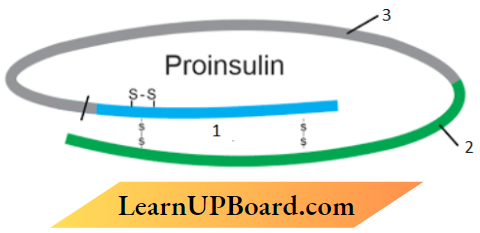
- State the change the proinsulin undergoes at the time of its processing to become functional.
- Name the technique the American company Eli Lilly used to commercialize human insulin.
How are the two polypeptides of a functional I insulin chemically held together?
Answer:
- a ‘C’ Peptide is removed
- rDNA technology or Recombinant DNA Technology.
- Disulfide bonds.
Important Questions for Class 12 Biology Chapter 9 – Biotechnology: Principles and Processes
Important Questions for Class 12 Biology Chapter 9 – Biotechnology: Principles And Processes Very Short Questions And Answers
Question 1. After the separation of DNA fragments by gel electrophoresis and staining with ethidium bromide, a student placed the gel in the UV chamber under the I-V light. State a reason for doing so.
Answer:
Explanation: After Gel electrophoresis the separated DNA is visualized after staining in ethidium bromide followed by exposure to UV light. The stained DN A fragments appear as orange-contoured bands.
Question 2.Assertion: When DN A from two different sources are cut fey the same restriction enzyme, the resultant DNA fragments have different kinds of sticky ends’.
Reason: These can be joined together end-to-end using DN A ligases.
- Both Assertion and Reason are true, and Reason is the correct explanation. Assertion,
- Both Assertion and Reason are true, but Reason is not the correct explanation of the Assertion.
- The assertion is true, but Reason is false.
- Both Assertion and Reason are false.
Answer: 1. Both Assertion and Reason are true, and Reason is the correct explanation of the Assertion.
Question 3. In biotechnology experiments, ‘molecular scissors’ used are
- Plasmid
- Restriction enzymes
- Vectors
- Sigma factor
Answer: 2. Restriction enzymes.
Question 4. Why do DNA fragments move towards the anode during gel electrophoresis?
Answer: DNA fragments are negatively charged.
Question 5. Write the function of a Bioreactor.
Answer: To produce the recombinant product in large quantities
Read and Learn More Important Questions for Class 12 Biology Chapter Wise
Important Questions for Class 12 Biology Chapter 9 – Biotechnology: Principles And Processes Very Short Questions And Answers Short Question And Answers
Question 1. How is the use of “microinjection” different from using the ‘method of biolistics’ in biotechnology? Explain.
Answer:
Recombinant DNA is directly injected into the nucleus of an animal cell in a method called microinjection. In another method, cells are bombarded with high-velocity micro-particles of gold or tungsten coated with DNA in a method known as biolistics or gene gun.
Question 2. How are DN A fragments visualized during gel-elect phoresis? What is elution?
Answer: Separated DNA fragments stained with ethidium bromide, followed by exposure to UV radiations, removal of DNA bands from agarose gel, and its extraction from gel is elution.
Question 3. Explain the principle that helps in the separation of DMA fragments in Gel electrophoresis.
Answer:
Since DNA fragments are actively charged molecules they can be separated by forcing them to run e towards an anode-pole under an electric field through a medium (matrix), DNA fragments separate according to their through-seeing effect picked in agarose gel (matrix)
Question 4.
1. Given below is the stepwise schematic representation of the process of electrophoresis.
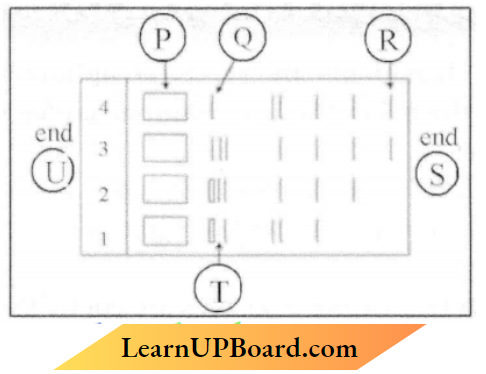
Identify the ‘alphabets’ representing
- Anode end
- The smallest or lightest DNA strand in the matrix
- Agarose gel
2. What is elution? State the importance of elution in this process.
Answer:
- Anode- S end
- R
- T
2. The separated bands of DN A are cut out from the agarose gel and extracted from the gel piece. This step is known as elution.
Importance:- The DNA fragments purified in this way are used in constructing recombinant DN A by joining them with cloning vectors.
Question 5.
1. Simple stirred-tank bioreactors are used to produce large quantities of recombinant proteins, stirring the contents and mixing them with oxygen. Write any four other advantages of using a stirred tank.
Answer:
- A stirred-tank reactor is usually cylindrical or with a curved base to facilitate the mixing of the reactor contents. The stirrer facilitates oxygen availability throughout the bioreactor that is tire bioreactor has an agitator system, an oxygen delivery system, a foam control system, and a temperature control system.
- pH control system, fermentation is contamination-free, and sampling ports so that small volumes of the culture can be withdrawn periodically.
2. After downstream processing, the product of the biosynthetic stage cannot be marketed directly. Why? Give two reasons.
Answer:
- After completion of the biosynthetic stage, the product has to be subjected to a series of processes before it is ready for marketing as a finished product The processes include separation and pu rill a ton. which are collectively referred to as downstream processing
- The product has to be formulated with suitable preservatives Such formulation has to undergo thorough clinical trials as in the case of drugs Strict quality control testing for each product is also required.
- The downstream processing and quality control testing vary from product to product.
Question 6. Explain only with the help of a self-explanatory diagram, the three basic steps of Polymerase Chain Reaction (PCR),
OR
Explain three steps involved in polymerase chain reaction.
OR
Describe the technique that is very effectively used to get a large amount of desired DNA for research and detailed investigation.
Answer:
- By using PCR (polymerase chain reaction) denatured desired DNA,
- Separate into 2 strands white each acting as a template
- For each strand, a separate set of pr mortised (two times).
- With the help of dextrin) nucleotides and I as polymerase DNA polvoiearase isolated from Thermus aquaticus)
- Results in extension of DNA primer
The process of PCR takes place in three steps
- Desaturation Two strands of DNA are separated by heating Each strand acts as a template.
- Annealing Two sets of primers are attached and annealed to the separated DNA strands
- Extension Taq polymerase catalyzes the extension of primers using genomic DNA as a template and nucleotides provided in the reaction.
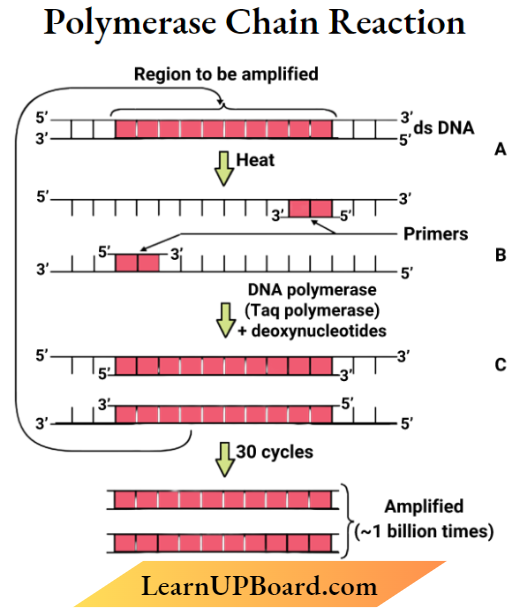
Question 7. Explain the three steps carried out in the formation of recombinant DNA using the enzyme EcoRI.
OR
Explain the action of EcoRI on DNA technology experiments.
Answer:
EcoRI cuts vector DNA. foreign DNA gene of interest. at palindromic site 3’CTTAAG 5’, 5’ GAATTC 3′ (between bases G and A only), sticky end (overhanging stretch of bases) formed at each strand Joining of sticky ends from DNA fragments by the enzyme DNA Ligase, Recombinant DNA(rDNA) is formed.
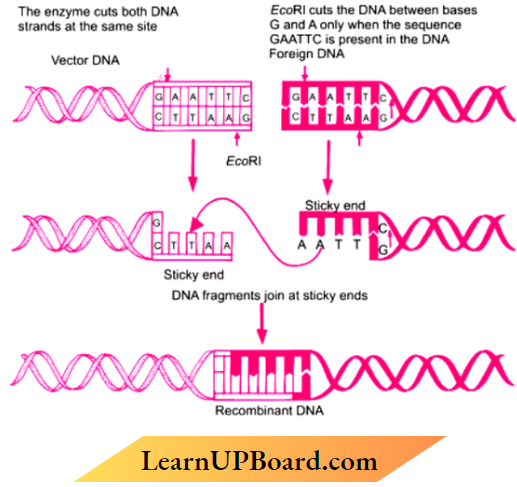
Question 8. Name any two natural cloning vectors. Give reasons that make them act as cloning vectors. Write the two characteristics the engineered vectors are made to possess
Answer:
Plasmids, bacteriophages, ability to replicate within bacterial cells. high copy number within the bacterial cells Characteristics of engineered Vectors: easy linking of foreign DNA, Selection of recombinants from non-recombinants or selectable markers.
Question 9. Name the most commonly used bioreactor in biotechnology labs. Mention the most essential components this bioreactor must have to provide the optimum conditions to the culture medium, resulting in the production of a large volume of the desired product.
Answer:
The most commonly used bioreactor is the stirring type.
It has the following components.
- Stirring type agitator system,
- O2 Delivery System
- Foam control system
- Temperature control system
- pH control system
Question 10.
- How has the development of bioreactors helped in biotechnology?
- Name the most commonly used bioreactor and describe its working.
Answer:
- Larger biomass large volume of culture can be processed leading to higher yields of desired specific products (protein or enzymes), under controlled condition
- Stirring type
- Mixing of reactor contents evenly (with an agitator system or a stirrer)
- Facilitates oxygen availability
- Temperature, PH1 foam control under optimum conditions
Question 11. Explain the roles of the following with the help of an example each in recombinant)NA technology:
- Restriction Enzymes –
- Plasmids
Answer:
- It recognizes a specific sequence of base pairs or palindromes. and cuts the D’NA strand at a specific site example EcoRI Hind 11
- Act as vectors cloning of desired alien gene or foreign gene eg pBR322 or plasmid of Salmonella or plasmid of Agrohacterimive Plasmid or Tumour including Plasmid
Question 12.
1. Explain the significance of ‘palindromic nucleotide sequence’ in the formation of recombinant DNA
Answer:
Palindromic nucleotide sequence The significance of the Palindromic nucleotide sequence is that the sequences read the same in both directions. This is important during the process of replication, transcription, and directional repair mechanisms.
2. Write the use of restriction endonuclease in the above process.
Answer:
- The same restriction endonuclease binds to both the vector and the foreign DNA, cutting each of the two strands of the double helix at specific points in their sugar-phosphate backbone of recognition sequence for restriction endonucleases ‘ palindromic sequence of vector and foreign DNA.
- Cut strands a little away from the center of the palindrome sites creates overhanging stretches or ticky ends
Question 13. Describe the roles of heat, primers, and the bacterium Thermus aquatic us in the process of PC R.
Answer:
- Heat – Denaturation or separation of DN A into two strands
- Primer– Enzyme DNA Polymerase extends the primers using the nucleotides provided in the reaction and the genomic DNA as a template.
- Thermus aqimfiats – Source of thermostable DNA polymerase: Taq polymerase
Question 14.Mention the role of (1) selectable marker, (2) Ori, and (3) drop-in Ecoli cloning vector pBR322.
Answer:
Selectable marker in addition to the vector requires a selectable marker, which helps in identifying and eliminating non-transformants and selectively permitting the growth of the transformants.
Origin of replication (ori): This is a sequence from where replication starts and any piece of DNA when linked to this sequence can be made to replicate within the host cells. This sequence is also responsible for controlling the copy number of the linked DNA. So, if one wants to recover mam copies of the target DNA it should be cloned in a vector whose origin supports high
copy number
Repressor of primer (Rop): It is a small dimeric protein that participates in the mechanism that controls the copy number of the plasmid It codes for the proteins involved in the replication of the plasmid
Important Questions for Class 12 Biology Chapter 9 – Biotechnology: Principles And Processes Long Question And Answers
Question 1. Read the paragraph given below and answer the questions that follow:
Enzyme Taq polymerase is extracted from a eubacteria microorganism Thermits aquaticus from Yellowstone National Park in Montana. ISA and isolated by Chien et al. (1976). Taq polymerase successfully replaced the DNA polymerase from E.coli that was being used in PCR earlier and this shift revolutionized the PCR technique,
- Taq polymerase after its discovery replaced E.coli DNA polymerase in the PCR technique. Explain giving reasons why the need felt for the change.
- What is a primer and its importance in PCR?
- What is the importance of PC R as a diagnostic tool?
Answer:
- The Lincoln DNA polymerase cannot cany out PCR at high temperatures (as it becomes inactive) whereas thermostable DNA polymerase (is isolated from a bacterium.
- Thermits that remain active during the high temperature-induced denaturation of double-stranded DNA.
- A primer is a small segment of DNA that binds to a complementary strand of DNA.
- Primers are necessary to start the functioning of DNA polymerase enzyme and therefore are necessary in polymerase chain reaction.
- PCR is important because it can generate several copies of a DNA sequence in a very short period.
- It is also important in forensic science as a tool for genetic engineering. Early detection of diseases like cancer AJDS genetic disorders.
Question 2. Restriction endonucleases are a class of bacterial enzymes that recognize a specific short sequence of nucleotides within a double-stranded DNA molecule The natural purpose of these enzymes is to protect bacteria from pathogens, notably bacteriophages. There are different classes of restriction enzymes, but type-11 restriction enzymes are widely used in manipulating DNA as they recognize short sequence nucleotides that are typically palindromes.
- Name a specific restriction endonuclease and write the palindromic nucleotide sequence in the DNA recognized by this enzyme. Also, indicate the site at which it cuts.
- A piece of DNA is cut by a restriction enzyme. The fragments are then separated by gel electrophoresis and stained by ethidium bromide. Write the principle on which gel electrophoresis works.
Answer:
1. EcoRl comes from Escherichia Coli RY 13 Recognition Sequence 5-GAATTC 3′
3’-CTTAAG-5’
The site at which it Cut 5’— G AATTC—3′
3’—CTTAA G—5′
2. The cutting of DNA by restriction endonucleases results in the fragments of DNA These fragments can be separated by a technique known as gel electrophoresis. Since DNA fragments are negatively charged molecules they can be. separated by forcing them to move towards the anode under an electric field through a medium/matrix. Nowadays the most commonly used matrix is agarose which is a natural polymer extracted from seaweeds. The DNA fragments separate (resolve) according to their size through the sieving effect provided by the agarose gel.
- Hence, the smaller the fragment size, the farther it moves. The separated DNA fragments can be visualized only after staining the DNA with a compound known as ethidium bromide followed by exposure to UV You can see bright orange colored bands of DNA in an ethidium bromide-stained gel exposed to UV light. The separated bands of DN A are cut out from the agarose gel and extracted from the gel piece
This step is known as elution. The DNA fragments purified in this way are used in constructing recombinant DNA by joining them with cloning vectors.
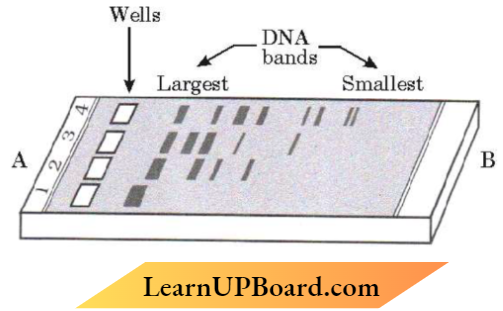
Question 3. Explain how an antibiotic resistance gene in a cloning vector (plasmid pBR322) helps in selecting the recombinants front the non-recombinants.
Answer:
- In the closing vector pBR322 the genes encoding for resistance to antibiotics such as ampicillin. tetracycline is considered as a selectable marker:
- These markers are used to identify and eliminate non-transformants and permit the growth of trial formats in media containing antibiotics.
For example, you can ligate a foreign DNA at the BartiH I site of the tetracycline resistance gene in the vector pBR322. The recombinant plasmids will lose tetracycline resistance due to the insertion of foreign DNA but can still be selected from non-recombinant ones by plating the transformants on a tetracycline-containing medium.
- The transformants growing on an ampicillin-containing medium are then transferred to a medium containing tetracycline.
- The recombinants will grow in an ampicillin-containing medium but not on that containing tetracycline. But. recombinants will grow on the medium containing both antibiotics.
Question 4.
- Write the mechanism that enables Agrobacterium impatiens to develop tumors in their host dicot plant.
- State how Agrobacterium tumefadmsand some retroviruses have been modified as useful cloning vectors.
Answer:
- file bacterium Agrobacterium tumefacient delivers a piece of DN A known as T-DNA present in its plasmid to transform the host plant cell into a tumor (and direct tumor cells to produce the chemical required by the pathogen).
- The Ti plasmid of A.tumifaciens has been disarmed 1 modified so that it is no longer pathogenic to the host plant but is still able to use the mechanism to deliver genes of interest into plants. Retroviruses have also been disarmed or modified now and are used as cloning sectors to transfer desirable genes into animal cells
Question 5.
- Name the most commonly used bioreactor. Why are these bioreactors used?
- How is the operation in a bioreactor carried out to achieve the desired end
Answer:
- Stirred tank bioreactor, to obtain large quantities of desired products from the culture medium containing cloned organisms with genes of interest
- By providing optimum growth conditions for the living materials such as temperatures of F1 substrate salts or vitamins oxygen(and four conditions)
(OR) Explain the process of amplification of genes of interest using PCR technique.
Answer: PCR – Technique
- Denaturation – The two strands of the gene of interest are separated as DNA templates under high-temperature
- Annealing – The two DNA primers attached to the two separated DNA template strands
- Extension – Taq polymerase extends the primers (in 5′ → 3′ using deoxynucleotides provided in the medium)
The Cycle is repeated to gel the multiple copies of the gene of interest
Important Questions for Class 12 Biology Chapter 9 – Biotechnology: Principles And Processes Case Study-Based Questions
Read The Following Passage And Answer Any Four Questions From 1 To 5 :
- Experiments involving cloning genes and expressing proteins require the use of host cells to receive the foreign cloned gene In some experiments, prokaryotes such as l’.. coli and Bacillus subtil is, and eukaryotes such as the budding yeast (Saccharomyces are used as host cells for DNA cloning.
- These host cells are relatively easy to grow in the laboratory and have been studied extensively for decades. Their genetics have been well-understood and therefore can be manipulated to make them appropriate hosts. Many types of cells can be converted into biochemical factories using rDNA technology to produce various kinds of biomolecules. coli and B. subtil are both commonly used as host cells for DNA cloning Fortunately, humans have become very experienced at cultivating microbes cheaply and efficiently on large and small production scales.
- Over the centuries, brewers and bakers have learned to employ yeast cells to manufacture beer, bread, and related food products. In terms of impact on human health, probably the most important product made by bacteria is antibiotics.
Question 1. The most commonly used eukaryotic microorganism used in biotechnology is :
- E.coli
- Bacillus
- Saccharomyces cerevisiae
- Drosophila
Answer: 1. E.coli
Question 2. Over the centuries, brewers and bakers have learned to employ yeast cells to manufacture man’s household products. Select the option with all the correct answers from the given list:
- Bread. Idli, Roquefort cheese
- Bread, Toddy, Swiss cheese
- Dosa, Idli, Bread
- Lipases, Pectinases, Zymase
Answer: 3. Dosa, Idli, Bread
Question 3. The most common products made by certain bacteria that have a great impact on human health are:
- Antibiotics.
- Bioactive molecules
- Enzymes
- Fermented drinks
Answer: 1. Antibiotics.
Question 4. The best-known host cells for DNA cloning and producing various kinds of biomolecules are:
- Agrobacteriumtumefaciens
- Escherichia
- Bacteriophage lambda
- Bacteriophage X174
Answer: 2. Escherichia
Question 5. The enzyme that is not required to manipulate the genetics of the microorganism to convert them into biochemical factories is :
- Restriction endonuclease
- DNA polymerase
- Lactase
- Ligase
Answer: 3. Lactase
Important Questions for Class 12 Biology Chapter 8 – Microbes in Human Welfare
Important Questions for Class 12 Biology Chapter 8 – Microbes In Human Welfare Question And Answers
Question 1. What for are Cyclosporin A anil Streptokinase bioactive molecules prescribed by a doctor
Answer:
- Cyclosporin A – It is used as an immunosuppressive agent.
- Streptokinase – It is used as a clot bluster for removing clots from blood vessels.
Question 2. Assertion: Large holes in ‘Swiss cheese’ are due to the production of a large amount of carbon dioxide by a specific microbe
Reason: The specificity of the characteristic texture, flavour and taste of Swiss cheese is due to the use of the bacterium Propionibacterium Sherman.
- Both Assertion and Reason are true, and Reason is the correct explanation of the Assertion.
- Both Assertion and Reason are true, but Reason is not the correct explanation of the Assertion.
- The assertion is true, but Reason is false
- Both Assertion and Reason are false.
Answer: 1. Both Assertion and Reason are true, and Reason is the correct explanation of the Assertion
microbes in human welfare
Question 3. Some cyanobacteria in aquatic and terrestrial environments that enrich the soil by fixing atmospheric nitrogen are
- Rhizobium and Azotobacter
- Azospirillum and Glomus
- Anabaena and Nostoc
- Azospirillumand Azotobacter
Answer: 3. Anabaena and Nostoc
Read and Learn More Important Questions for Class 12 Biology Chapter Wise
Question 4. The microbes commonly used in kitchens are
- Lactobacillus and Yeast
- PeniciiHum and Yeast
- Microspora and E.coli
- Rhizopus and
Answer: 1. Lactobacillus and
Important Questions for Class 12 Biology Chapter 8 – Microbes In Human Welfare Short Question And Answers:
Question 1. Fanners are often suggested to use the following organisms in their cropland to improve soil fertility. Explain.
- Rhizobium
- Anabaena
Answer:
- Rhizobium is a bacterium found in soil that helps in fixing nitrogen in leguminous plants
- It attaches to the roots of the leguminous plant and produces nodules. These nodules fix atmospheric nitrogen and convert it into ammonia that can be used by the plant for its growth and development.
- Anabaena plays a significant role in farming where it is used as a biofertilizer and soil stabilizer.
Question 2. Organic farmers use Trichoderma and liacuas as biological control agents. Explain.
Answer:
- Trichoderma – species are free-living fungi that are very common in the root ecosystems. They are effective biocontrol agents of several plant pathogens Baculoviruses are pathogens that attack Insects and other arthropods.
- Baculovirus – The majority of baculovirus ruses used as biological control agents are in the genus Nucleopolyhedrovtrus. These viruses are excellent candidates for species-specific, narrow-spectrum insecticidal applications. They have been shown to have no negative impacts on plants, mammals, birds, fish or even on non-target insects.
“human health and welfare “
Question 3. A particular cyanobacterium is spread by (lie farmers in their fields while growing paddy). Name the cyanobacteria used and give two advantages of it.
Answer:
Cyanobacteria like Anaebena. Nosiocetc can fix atmospheric No, decompose organic wastes and residues, detoxify heavy metals, pesticides, and other xenobiotics, catalyze nutrient cycling, suppress the growth of pathogenic microorganisms in soil and water, and produce some bioactive compounds that contribute to plant growth.
Question 4. Study the given diagrams of Sewage Treatment Plants (STP) and answer the questions that follow:
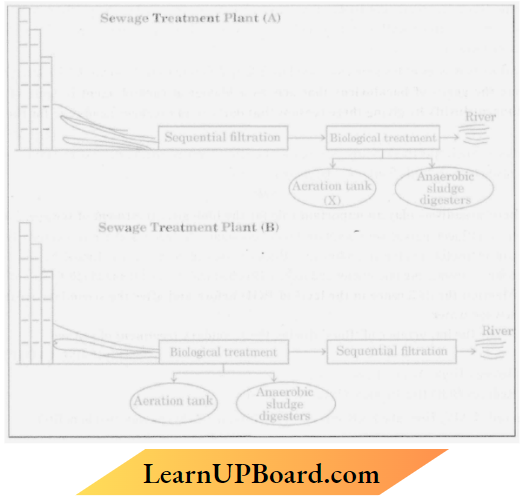
- Which of the two Sewage Treatment Plants? (A) or (B), will be more effective in treating human excreta in municipal waste?
- How is the primary effluent treated in the aeration tanks till there is a significant reduction in the BOD of (the effluent?
Answer:
- Sewage Treatment Plants (A) will be more effective in treating human excreta in municipal waste.
- The primary effluent is taken to aeration tanks, where it is constantly agitated mechanically. Air is pumped into it. periodically A large number of aerobic heterotrophic microbes grow in the aeration tank to form floes.
- Due to microbial activity, the organic matter gets digested The microbes convert it into microbial biomass and release the minerals Due to the breakdown of organic matter, the BOD (biochemical oxygen demand) of the wastewater reduces to about 10 to 15% of raw sewage.
“human welfare society plan pdf “
Question 5. Write the different components of activated sludge. Explain the different ways it can be used further in the sewage treatment process.
Answer:
- Dining secondary treatment BOD- of sewage or wastewater is reduced significantly the effluent is then passed into a settling tank where the bacterial “floes are allowed to sediment called activated sludge.
- The floes are masses of bacteria associated with fungal filaments to form mesh-like structures.
Question 6.
1. Name the genus of baculovirus that acts as a biological control agent despite being a pathogen. Justify by giving three reasons that make it an excellent candidate for the job,
Answer:
Genus – Nucleopolyhedrovirus, species-specific, Narrow spectrum. No negative impact on (plants or mammals or birds or fish) non-target organisms.
2. ‘’Micro-organisms play an important role in the biological treatment of sewage.” Justify
Answer:
Primary effluent is passed into aeration tanks, constantly agitated and the air is pumped in. This allows the growth of useful aerobic microbes into flow or masses of bacteria and fungal filaments), these microbes consume organic matter and reduce the Biochemical oxygen demand (BOD) of effluent.
Question 7.
- Mention the difference in the level of BOD before and after the secondary treatment of sewage water.
- Write the importance of floes during the secondary treatment of sewage.
Answer:
1. Before – High. After- Low
2. Reduces BOP Biochemical Oxygen Demand
Question 8. Expand ‘LAB’. How are LABs beneficial to humans? (Write any two benefits).
Answer:
Lactic Acid Bacteria,
- They produce acid which partially digests the milk protein or sets milk into curd.
- They improve nutrition and quality by producing Vitamin B.
- Check disease-causing microbes in our stomach
Question 9. Your advice is sought to improve the nitrogen content of the soil to be used for the cultivation of a noil-leguminous terrestrial crop.
- Recommend two microbes that can enrich the soil with nitrogen.
- Why do leguminous crops not require such enrichment of the soil?
Answer:
- Azospiri/fum Azotobacter Anabaena Nosioc Oscillaloriu rankia
- They can fix atmospheric nitrogen, due to the presence of Rhizobium which is a V-fixing bacteria in their root nodules.
microbes in human welfare notes pdf download
Question 10. Why are microbes like Spirulina being produced on a commercial scale? Mention its two advantages.
Answer:
- As a source of food protein.
- Reduces environmental pollution or solves the problem of hunger and malnutrition or a rich source of protein or low-cost production.
Question 11.Name (the microbes that help the production of the following products commercially:
- Statin
- Citric acid
- Penicillin
- Butyric acid
Answer:
- Monascus purpureas
- Aspergillus
- PenicilHum notatum
- Clostridium butylicum
Question 12. Name the first antibiotic discovered and by whom.
Answer: Penicillin by A. Fleming.
Question 13. What is the pathogenic property of baculovirus, used as a biological agent? Name the genus of these organisms.
Answer:
- Baculoviruses are pathogens that attack insects and other arthropods.
- The majority of baculoviruses used as biological control agents are in the genus
Question 14. Explain the changes that mills undergo when a suitable starter or inoculum is added to it. flow does the end product formed prove to be beneficial for human health?
Answer:
Lactobacillus lactic acid bacteria (LAB) present in inoculum, grows in milk at a suitable optimum temperature, multiplies converting milk to curd,-and produces acids that coagulate and partially digest the milk proteins. This improves its nutritional quality by increasing Vitamin B12, and LAB checks diseases causing.
Question 15. Why does an organic farmer intentionally not use toxic chemicals to kill the pests which damage the last crops? Explain giving three reasons.
Answer:
- Toxic chemicals can have adverse side effects cause biomagnification,
- it kills both useful and harmful life forms indiscriminately,
- It eradicates pests not control pests,
- Beneficiary predatory and parasitic insects which depend upon them as food or hosts would not be able to survive,
- It disturbs the food chain food webs or vibrant ecosystems.
Question 16.
1. Organic farmers prefer biological control of diseases and pests to the use of chemicals for the same purpose. Justify.
Answer:
- Reduces dependence on toxic chemicals.
- Protects our ecosystem or environment.
- Protects and conserves non-target organisms they are species-specific.
- These chemicals being non-biodegradable may pollute the Permanently.
- These chemicals being non-biodegradable may cause biomagnification.
2. Give an example of a bacterium, a fungus and an insect that are used as biocontrol agents.
Answer:
- Bacteria Bacillus thuringiensis Fungus Trichodcnva.
- Insect Lady bird or Dragonfly or Moth.
Question 17. The three microbes are listed below. Name the product produced by each one of them and mention their use.
- spergillusniger
- Trichodermtt polysporum
- Monascus purpure
Answer:
- Aspergillus niger – Citric Acid, natural preservative or flavouring agent.
- Trichodennapolysporum – Cyclosporin A, immunosuppressive agent.
- Monascus purpureas – Statin, blood cholesterol-lowering agent.
Question 18. Baculoviruses are good examples of biocontrol agents. Justify by giving three reasons.
Answer:
- Species-specific narrow-spectrum insecticidal application
- They have no negative impact on plants mammals or birds or fish or non-target insects
- They are beneficial for 1 PM (Integrated Pest Management) or the Pest Management Programme.
microbes in human welfare class 12 ncert
Question 19. Secondary treatment of the sewage is also called Biological treatment. Justify this statement and explain the process.
Answer:
Involves biological organisms such as aerobic and anaerobic microbes or bacteria and fungi to digest or Consume organic waste Primary effluent is passed into an aeration tank where vigorous growth of aerobic microbes (floes) takes place. BOD is reduced (microbes consume a major part of organic matter), effluent is passed to a settling tank where floe sediment produces activated sludge, and sludge is pumped to an anaerobic sludge digester to digest bacteria and fungi.
Question 20. Identify A, B, C, D, and E and find the following table :
Answer:

- Streptokinase
- ‘clot buster’
- cyclosporin A
- Trichoderma polysporrum.
- Monascus purpureus
- Blood-cholesterol-lowering agents.
Important Questions for Class 12 Biology Chapter 8 – Microbes In Human Welfare Long Question And Answers
Question 1. Describe the process of secondary treatment given to municipal wastewater (sewage) before it can be released into fresh waterbodies. Mention another benefit provided by this process.
Answer:
Process of secondary treatment Passing of primary effluent into a large aeration tank which is constantly agitated mechanically and air is pumped into it allowing vigorous growth of useful aerobic microbes into floes
↓
Microbes consume a major part of organic matter in effluent which significantly reduces BOD
↓
Now effluent is passed into a settling tank where floes are allowed to settle or sediment called activated sludge
↓
Digestion of activated sludge by anaerobic microbes and effluents from secondary treatment can be released into river or stream
↓
This resulted in the production of Biogas (CH4, IBS and CO2) which can be used as a source of energy.
Class 12 Biology Chapter 7 Human Health and Disease
Class 12 Biology Chapter 7 Human Health And Disease Very Short Question And Answers
Question 1. write the scientific name of the causative Lent of pneumonia in humans and mention one specific symptom of the disease.
Answer:
Bacteria like Streptococcus pneumoniae and Haemophilus influenzae are responsible for die disease pneumonia. The symptoms of pneumonia include fever, chills, cough and headache.
Question 2. Expand MALT and mention any one location of it in the human body.
Answer:
The mucosa-associated lymphoid tissue (MALT), also called mucosa-associated lymphatic tissue, is a diffuse system of small concentrations of lymphoid tissue found in various submucosal membrane sites of the body, such as the gastrointestinal tract, nasopharynx, thyroid, breast, lung, salivary glands, eye, and skin.
human health and disease
Question 3. For early detection of cancer, 3-D images of tissues are essential. Name the technique and the basis on which it can generate a three-dimensional image of changes in the IMtig tissue.
Answer:
Medical imaging is the technique and process of imaging the interior of a body for clinical analysis and medical intervention, as well as visual repair of the juice the organs
Of tissues (physiology). Medical imaging seeks to reveal internal! structures are hidden by the skin and bones, as well as to diagnose and treat disease.
Read and Learn More Important Questions for Class 12 Biology Chapter Wise
Question 4. The main barrier that prevents the entry of micro-organisms into our body is
- Antibodies
- Macrophages
- Monocytes
- skin
Answer: 4. Skin
Question 5. Colostrum provides passive immunity to human infants as it contains antibody
- IgA
- IgM
- tgE
- igG
Answer: 1. IgA
Question 6. Name any two physiological barriers that provide innate immunity.
Answer:
Acid in Stomach, Saliva in mouth
Question 7. Name the pathogen which causes Typhoid. Name the test that confirms the disease.
Answer:
Salmonella typhl,w idal test
Question 8. How does the body respond when harmony in produced hy is released in its blood?
OR
Write the role of interferons.
Answer:
Chill and high fever occur, in regular intervals every 3 to 4 days.
OR
Virus-infected cells secrete proteins called interferons, which protect non-infected cells (from further viral infection )
Question 9. Name two diseases whose spread can be controlled by the eradication of Aedes mosquitoes.
Answer:
Dengue and Chikunguniya.
Question 10. How do cytokine barriers promote innate immunity in humans?
Answer:
Interferon (proteins) which is secreted by virus-infected cells protect non-infected cells from further viral infection
Question 11. Flow do monocytes act as a cellular barrier in humans to provide innate immunity?
Answer:
Phagocytosis of microbes or destroy microbes.
Question 12. Name the condition in vertebrates where the body attacks self-cells.
Answer:
Autoimmunity.
Class 12 Biology Chapter 7 Human Health And Disease Short Questions And Answers
1. A body developed some allergic reactions when he straight entered his air-conditioned room after a game of football outside his house. Write any two symptoms that could be noticed in such a condition. How does our body combat such conditions?
Answer:
Symptoms of allergic reactions include sneezing, watery eyes, runny nose and difficulty in breathing. The immune system overreacts by producing antibodies called Immunoglobulin E (IgE). These antibodies travel to cells that release chemicals, causing an allergic reaction
evolution pdf
Question 2.
1. Write the Scientific name of the plant from where natural cannabinoids are obtained.
2. Mention the parts of the plant that are used for extracting the drug.
3. How does the drug affect the human body?
OR
The epithelial lining of our intestine is considered a secondary lymphoid organ. Justify the statement.
Answer:
1. Condition saliva
2. Cannabinoids are obtained from the inflorescence of the plant.
3. These drugs affect the cardiovascular system of the body. They affect brain areas that influence pleasure, memory, thinking, concentration, movement and coordination.
OR
There is lymphoid tissue also located within the lining of the major tracts (respiratory, digestive and urogenital tracts) called mucosal-associated lymphoid tissue (MAtT) It constitutes about 50 per cent of the lymphoid tissue in the human body
Question 3. The major cause of death among infants is because of Vcute Respirators Infection ( XRI) of the lower respiratory tract, which further affects the alveoli. Name the associated disease, and a causative bacteria and give any two symptoms of the disease.
Answer:
The associated disease is pneumonia and the most common bacteria causing pneumonia is Streptococcus pneumoniae.
Symptoms:-
Fast or Laboured Breathing – Breathing patterns would be rapid but shallow, directed from the stomach instead of the chest, accompanied by wheezing.
Pale Skin – The skin around the lips and face starts turning blue (a sign of decreased oxygen in the bloodstream).
Pain – Depending on the infected part, he will experience pain in the lungs or the abdomen. Especially when coughing or breathing deeply
Question 4.
1. In our country YVC’O and other Non-Government Organisations (NGOs) are doing a lot to educate people about AIDS. Expand ’NACO’. Enlist any three ways by which transmission of HIV- AIDS infection occurs.
Answer:
National Aids Control Organization
Ways of Transmission
- Mother-to-child transmission is the most common way that children get HIV & This is called perinatal transmission It is less common because of advances in HIV prevention and treatment,
- Used needles, syringes, and other injection equipment may have someone raise blood on them, and blood can carry HIV with someone who has HIV
- The primary way in which HIV’ is transmitted from person to person is when a partner has unprotected vaginal or anal sex with an HIV-positive partner.
2. write the scientific name of the plant and the part from which opioids are extracted. How does it affect our body functions?
Answer:
- Opioids are extracted from the late plant called tie opium poppy, whose scientific name is Papaver souvenir.
- Receptors are present m the central nervous system, cardiomiscible system and gastrointestinal tract.
- Opioids act as a depressant and slow down body functions.
“highlighted ncert biology pdf class 12 “
Question 5. It is often observed that the chances of a person suffering from measles in his or her lifetime are low if he or she has suffered from the disease in their early childhood. Justify the statement.
Answer:
Memory cells develop during measles in early childhood, subsequent encounters with the same pathogen elicit a highly intensified secondary anamnestic response.
Question 6. A student on a field trip suddenly felt breathlessness and started to sneeze very badly. Name this response and explain what it is due to.
Answer:
Allergy Allergens (dust or pollen mites etc.) are due to the release of chemicals like histamine serotonin (from mast cells).
Question 7. Causative organisms of some diseases gain entry into the human body through mosquito bites and make humans suffer from the disease. Name one such:
- protozoan disease along with the scientific name of the causative organism.
- Helminths disease along with the scientific name of the causative organism.
Answer:
- Malaria → Plasmodium vivax Plasmodium malaria Plasmodium falciparum
- Elephantiasis/Filariasis → Wuchereria bancrofti Wuchcicria malayi
Question 8. Write the functions of bone marrow as the primary lymphoid organ and lymph nodes as the secondary lymphoid organs.
Answer:
Bone Marrow-lymphocytes are produced here, develop and mature into antigen-sensitive lymphocytes
Lymph nodes – trap the microorganism or antigens from the tissue fluid, the trapped antigens activate the lymphocytes (present in lymph nodes) to cause an immune response.
OR
What is a vaccine? State the type of immunity that it induces.
Answer:
The vaccine is a weakened/inactivated pathogen, or its antigenic protein, Active immunity
Question 9.
1. Name the source plant of heroin drug. Mow is it obtained from the plant?
Answer:
Papaver somtiifermnlPoppy plant.
Extracted from the latex of the plant or acetylation of morphine (obtained from the latex of the plant)
2. Write the effects of heroin on the human body.
Answer:
Depressant slows down body function
Question 10. Why is the structure of an antibody molecule represented as ILL2? Name any two types of antibodies produced in the human body.
Answer:
L 2 – Two light or small polypeptide chains,
Ha,” two heavy or longer polypeptide chains.
I gA / I gM / I gE / I gG
Question 11. Mention one application for each of the following :
- Passive immunization
- Antihistamine
- Colostrum
- Cytokinin-barrier
Answer:
- Provide preformed antibodies anti-toxins for quick response in ca microbes! tetanus) or snake bite.
- Reduces symptoms of allergy
- Provides passive immunity, antibodies or IgV to newborns.
- Protection of non-infected cells from further viral infection
Question 12.
1. Write the complete name of the diagnostic test for AIDS. Explain the principle it works on.
Answer:
ELISA Enzyme Linked Immune Sorbent Assay. It is based on the principle of antigen-antibody interaction where a pathogen can be detected by the presence of antibodies (proteins, glycoproteins, etc.) on it
“evolution class 12 ncert pdf notes “
2. Name the type of genetic material present in the AIDS-causing pathogen.
Answer:
MIX is a retrovirus, which means it carries single-stranded RNA as its genetic material rather than the double-stranded DNA human cells carry.
Question 13. A patient complains of suffering from constipation, stomach ache, stool with blood clots and excess mucous. The physician diagnosed it as amoebiasis, after a stool test.
- Write the scientific name of the microbe identified in the stool sample.
- How do you think, the patient must have contracted it?
- Write your suggestions to the patient to avoid infection in future.
Answer:
- Entamoeba histolytica
- I houseflies act as mechanical carriers and serve to transmit the parasite from the faeces of infected persons to food and food products, thereby contaminating them. Drinking water and food contaminated by faecal matter are the main sources of infection.
- Perform hand hygiene frequently, especially before handling food or eating, and after using the toilet or handling faecal matter Wash hands with liquid soap and water, and rub for at least 20 seconds.
Question 14. Name any two techniques which can be used to generate a three-dimensional image to detect cancers of the internal organs and explain any one of the techniques.
Answer:
Techniques like radiography (use of X-rays), CT (computed tomography) and MRI (magnetic resonance imaging) are very useful in detecting cancers of the internal organs.
Magnetic resonance imaging (MRI): Magnetic resonance imaging (MRI) is a spectroscopic imaging technique used in medical settings to produce images of the inside of the human body MRI is based on the principles of nuclear magnetic resonance (NMR). which is a spectroscopic technique used to obtain microscopic chemical and physical data about molecules.
Magnetic resonance imaging is accomplished through the absorption and emission of energy of the radio frequency (RF) range of the electromagnetic spectrum
MRI Uses
- Utilizes non-ionizing radiation (unlike X-rays)
- Ability to image in any plane, (unlike CT scans).
- Very low incidents of side effects.
- Ability to diagnose, visualize, and evaluate various illnesses.
Question 15. Given Below Is A Diagrammatic Representation Of the Immune System Of The Human Body:
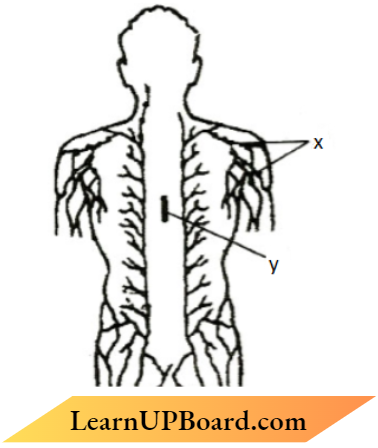
- Identify ‘ X’and ’Y’ in the given diagram.
- Explain two major functions of the organs that you have identified,
Answer:
1. X – Lymph Nodes
Y – Thymus
2. Lymph Nodes –
- The removal of excess fluids from body tissues.
- Absorption of fatty acids and subsequent transport of fat, and chyle, to the circulatory system
- Production of immune cells (such as lymphocytes, monocytes, and antibody-producing cells called plasma cells).
- There is lymphoid tissue also located within the lining of the major tracts (respiratory, digestive and urogenital tracts) called mucosa-associated lymphoid tissue (MALT) It constitutes about 50 per cent of the lymphoid tissue in the human body.
Thymus – The thymus gland is a lobular structure located between the lungs behind the sternum on the ventral side of the aorta.
- The thymus plays a major role in the development of the immune system.
- This gland secretes the peptide hormones called thymosins.
- Thymosins play a major role in the differentiation of T – T-lymphocytes, which provide cell-mediated immunity.
- Thymosins also promote the production of antibodies to provide humoral immunity.
- Thymus is degenerated in old individuals resulting in a decreased production of thymosins.
- As a result, the immune responses of old persons become weak.
Question 16. Answer the following questions concerning “opioids”, the commonly abused drug :
- Where in our body are the specific opioid receptors present?
- What is heroin chemically known as?
- Write the scientific name of the plant from which opioids are extracted.
Answer:
- Opioids are drugs, which bind to specific opioid receptors present in our central nervous system and gastrointestinal tract.
- Heroin commonly called smack is chemically known as diacetylmorphine.
- Papaver sonmifentni.
Question 17. Name the two primary lymphoid organs in humans. Explain their functions in providing immunity.
Answer:
Bone Marrow: The main lymphoid organ where all blood cells including lymphocytes are produced
Thymus:
- A lobed organ located near the heart arid beneath the breastbone
- Quite large at the time of birth but keeps reducing in size with age and by the time puberty is attained it reduces to a very small size
Question 18.
- Name the causative agents of pneumonia and the common cold.
- How do these differ in their symptoms?
- Mention two symptoms common to both.
Answer:
1. Streptococcus pneumoniae Haemophilus influenza, rhinoviruses
2. Different symptoms
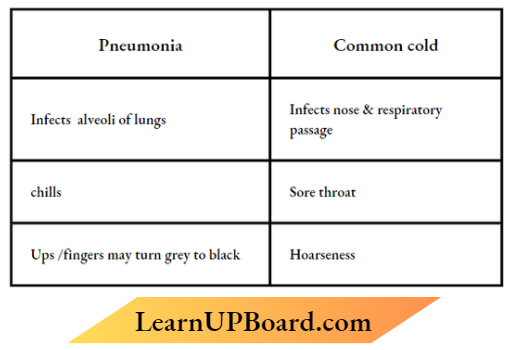
3. Common symptoms
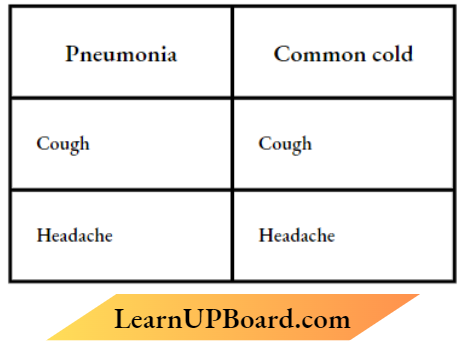
Or
- Write the scientific names of the causative agent and vector of malaria, and write its symptoms.
- Name any two diseases spread by Aedes sp.
Answer:
- Plasmodium vivax P. falciparum P.malariae,vector-female Anopheles mosquito Symptoms chills, high fever
- Dengue, Chikungunya
Question 19. Name is a human disease, its causal organism, symptoms (any three) and sector, spread by intake of water and food contaminated by human faecal- matter.
Answer:
Amoebiasis (Amoebic dysentery). Entamoeba histolytica, constipation abdominal pain cramps or stools with excess mucus or blood clots & causing agent is Housefly.
OR
Ascariasis. A scar is, internal bleeding muscular pain fever anaemia or blockage of intestinal passage and The causing agent is Housefly.
OR
Typhoid, Salmonella n phi, high fever weakness stomach pain or constipation headache or loss of appetite and the causing agent is Housefly.
OR
- Why is there a fear among the guardians that their adolescent wards may get trapped in drug or alcohol abuse?
- Explain ‘addiction” and ‘dependence’ in respect of drug/alcohol abuse in youth.
Answer:
- Adolescents are easily affected by this. (vulnerable to) peer pressure adventure or curiosity excitement or experimentation or media
- Addiction- Psychological attachment to certain effects such as Euphoria or temporary feeling of well-being Dependence- Tendency of the body to show withdrawal syndrome or symptoms if regular doses of drug/alcohol are abruptly discontinued.
Question 20.
1. What is an “allergic reaction”?
Answer:
The exaggerated response of the immune system to certain antigens present in the environment is called allergy The substances to which such an immune response is produced are called allergens.
2. Name any two drugs used to quickly reduce the symptoms of allergy.
Answer:
Anti-histamine, adrenalin and steroids
3. Why do more and more children in metro cities of India suffer from allergies and asthma?
Answer:
More and more children in metro cities of India suffer from allergies and asthma due to sensitivity to the environment. This could be because of the protected environment provided early in life.
Class 12 Biology Chapter 7 Human Health And Disease Long Question And Answer
Question 1. It is commonly observed that parents feel embarrassed to discuss freely with their adolescent children about sexuality and reproduction. The result of Ibis parental inhibition is that the children go astray sometimes.
- Explain the reasons that you feel are behind such embarrassment amongst some parents to freely discuss such issues with their growing children.
- By taking one example of a local plant and animal, how would you help these parents overcome such inhibitions about reproduction and sexuality?
Answer:
- Illiteracy or conservative attitudes or misconceptions social myths etc. are the main reasons.
- If a student gives the clarity of the concept of reproduction and sexuality by taking an example of a plant and an animal to reproductive organs, gamete formation fertilization, sexual behaviour etc.
Question 2.
1. Differentiate between active and passive immunity.
Answer:
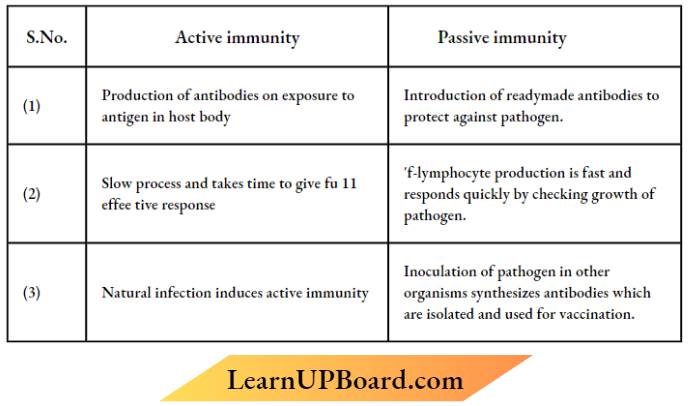
2. Comment on the role of vaccination and immunization in keeping the human population healthy.
Answer:
Role of vaccination or immunization:
- Antibodies produced in the body against antigens neutralize pathogenic agents.
- Vaccines also generate memory cells (B and T cells) that recognize quickly subsequent exposure and control the growth of pathogens with massive production of antibodies.
- Preformed antibodies or antitoxin protect our body from deadly microbes like tetanus and against snake venom.
Class 12th Biology Important Questions Chapter 6 Evolution
Class 12th Biology Important Questions Chapter 6 Evolution Very Short Question And Answers
Question 1. Mention one example each from plants and animals exhibiting divergent evolution.
Answer:
Thorn of Bougaimilira and tendrils of Cucurbita, forelimbs of whales bats, cheetahs,s and humans (all mammals or vertebrate hearts or vertebrate drains
Question 2. Write the names of the following:
- A 15 ape-like mya primate
- A 2 mya primate that In ed in East African grasslands
Answer:
- Dryopithecus
- Australopithecines or Australopithecus or Homo habilis
Question 3. State two postulates of Oparin and Haldane concerning the origin of life.
Answer:
- The first form of life could have come from existing non-living organic molecules RNA And Protein
- Formation of life was preceded by chemical evolution or formation of diverse organic, molecules from inorganic coast entrants
“molecular basis of inheritance class 12 notes bank of biology “
Class 12th Biology Important Questions Chapter 6 Evolution Short Question And Answers
Question 1. Wings of birds and wings of butterflies contribute to locomotion, and the evolution of such organs is a result.
Answer:
They are not anatomically similar in structure but perform the same function, hence these are analogous structures type of evolution is convergent evolution similar habitats of birds and butterflies have resulted in. the selection of similar adaptive features (wings.) in different groups of organisms, but towards the same function convergent evolution.
Read and Learn More Important Questions for Class 12 Biology Chapter Wise
Question 2. According to the Darwinian theory of natural selection, the rate of appearance of new forms is linked to the life cycle or the life span of an organism. Explain with the help of an example.
Answer:
A colony of bacteria (say A) growing in a given medium has built-in variation in terms of the ability to utilize a feed component, a change in the medium composition would bring out only that part of the population B) that can survive under the new conditions In due course of time this variant population outgrows the others and appears as new species thus organisms with shorter life-cycle or life-span will undergo evolution faster or for the same thing to happen in fish or fowl would take millions of years as life spans of these animals are in years.
Question 3. Explain the Ilardy-Weinberg principle with the help of an algebraic equation.
Or
With the help of an algebraic equation, how did Ilardy-Weinberg explain that in a given population the frequency of occurrence of alleles of a gene is supposed to remain the same through generations?
Answer:
The Principle says that allele frequency in a population is stable and is constant from generation to generation, the gene pool remains constant and expressed as p2 +2pq+ q2/ ( p+q)2
- Where p2 = frequency of individuals with A A genotype
- Where q2= frequency of individuals with a genotype
- Where 2pq = frequency of individuals with Aa genotype
“biology class 12 ch 6 “
Question 4. What is adaptive radiation? How did Darwin explain it?
Answer:
The process of the evolution of different species in a given geographical area starting from a point and radiating to other areas of geography (habitats) is called adaptive radiation He observed that there were many different varieties of finches (Darwin’s finches) in the same island, and all those varieties evolved ou the island itself, from the original seed-eating features many other forms with altered beaks arose to become insectivorous or vegetarian finches.
Question 5.
1. Differentiate between analogous and homologous structures.
Answer:
- Aitalogous-Anatomically embryonic development, origin, and structure are not similar though perform similar functions and are a result of convergent evolution.
- Honiologus – Anatomically embryonic development, origin, and structure are similar (but perform different functions) and are a result of divergent evolution.
2. Select and write analogous structures from the list given below :
- Wings of butterflies and birds
- Vertebrate hearts
- Tendrils of bougainvillea and cucurbita
- Tubers of sweet potato and potato
Answer: 1 Or 4
Question 6. How can the Hardy- Weinberg Equilibrium be affected? Explain giving three reasons.
Answer:
- Gene Migration Or Gene Flow: When the migration of a section of the population occurs to another place and gene frequencies change in the original as well as in the new population.
- Genetic drift: If the same change occurs by chance or new genes or alleles are added to the new population and these are lost from the old population.
- Mutation: Pro existing advantageous mutations when selected will result in new phenotypes.
- Genetic recombination: Variation in characteristics will be there because of genetic recombination, during meiosis and also due to random fusion of gametes.
- Natural selection: Heritable variations enabling better survival enabled organisms to reproduce and leave a greater number of progeny.
Question 7. Write the characteristics of Raniapithecus, Drvopitheeiis, and Neanderthal man.
Answer:
- Raniapithecus: I fairy Or walked like gorillas and chimpanzees, more man-like.
- Drvopitheeiis: Hairy or walked like gorillas and chimpanzees, more aped ike.
- Neanderthal man: brain size is 1400cc, used hides to protect their body or buried their dead,
Question 8. Excessive and continuous use of pesticides has resulted in the evolution of some new species of pests. Explain what must have led to this. What is this type of evolution called?
Answer:
- Excess use of herbicides, pesticides, etc. only resulted in the selection of resistant varieties in a much lesser time scale.
- Hence, resistant organisms seel Is appear in a time scale of months or years and not centuries.
- These are examples of evolution by anthropogenic action.
- This also tells us that evolution is not a directed process in die sense of determinism.
- It is a stochastic process based on chance events in nature and chance mutation in the organisms.
“class 12th biology molecular basis of inheritance “
Question 9. What type of organs eye of an Octopus and that of a human called? Give another example from the animal group and one from the plants of such organs. Name and explain the evolutionary process they exhibit.
Answer:
- The eyes of the octopus and mammals are an example of analogous organs. Sweet potato (root modification) and potato.
- Wings of butterflies and birds.
- The similar habitat has resulted in the selection of similar adaptive features in different groups of organisms but toward the same function, analogous structures are a result of convergent evolution – different structures evolving for the same function and hence having similarity.
Class 12th Biology Important Questions Chapter 6 Evolution Long Question And Answers
Question 1.
1. Describe the observations made on the collection of white-winged moths and dark-winged moths in England between the years 1850 and 1920. What did these observations lead to?
Answer:
Before industrialization tree bark was covered with light-colored lichens, In this background white-winged moth survived but dark colored moth was picked out. by predators, post-industrialization tree trunks became- dark due to industrial smoke and soot, under this condition, and the white-winged moth did not survive due to predators, while the dark-winged/melanized moth survived, this showed that organism that is better adapted to survive are selected by Nature/Natural selection.
2. How is the use of herbicides, pesticides, and antibiotics by humans for various purposes, comparable with the observations made on moths in the above question? What is this type of phenomenon called?
Answer:
Excessive use of these chemicals has resulted in the selection of resistant varieties, in u much lesser time (scale).
These are examples Of evolution by anthropogenic action.
Question 2. Describe S.E. Miller’s experiment. Comment on the observations he made and his contribution towards the origin of life on Earth.
Answer:
High temperature (800″C), high energy radiation, reducing atmosphere created, by electric discharge in a closed flask, containing CH4, IE. NIC. and water vapors in the experimental setup.
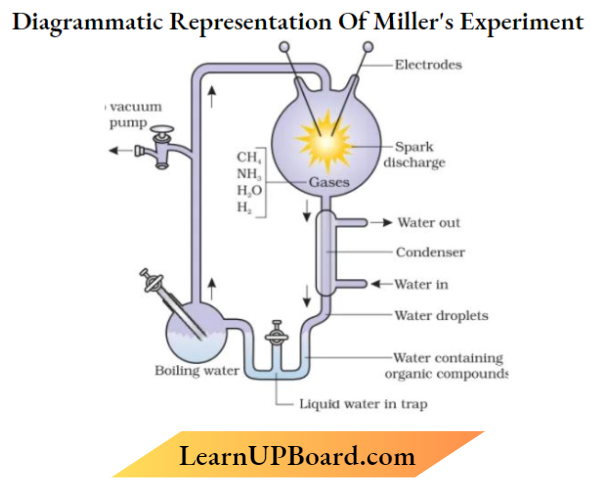
bank of biology class 12 molecular basis of inheritance
Observation and Contribution
- Formation of amino acids
- The first form of life arose slowly through evolutionary forces in front of living molecules or abiogenesis.
Question 3. Taking an example of white-winged moths and dark-winged moths of England in pre and post-industrialised eras, explain evolution by natural selection.
Answer:
An interesting observation supporting evolution by natural selection comes from England In a collection of moths made in the 1850s, therefore before industrialization set in, it was observed that there were more white-winged moths on trees than dark-winged or melanic moths.
- However, in the collection carried out from the same area, but after industrialization, in 1920, there were more dark-winged moths in the same area, therefore the proportion was reversed.
- The explanation put forth for this observation was that ‘predators will spot a moth against a contrasting background’.
- During the post-industrialization period, the tree trunks became dark due to industrial smoke and soot. Under this condition, the white-winged moth did not survive due to predators, dark winged or melanised moth survived.
- Before industrialization set in, thick growth of almost white-colored lichen covered the trees – in that background, the white-winged moth survived but the Clark color. red moth was picked out by predators.
- Lichen will not grow in areas that are polluted. Hence, moths that were able to camouflage themselves, therefore, hide in the background, survived.
- This understanding is supported by the fact that in areas where industrialization did not occur example in rural areas, the count of matric moths was low.
- This showed that in a mixed population, those that can better adapt, survive and increase in population size. Remember that no variant is completely wiped out.
